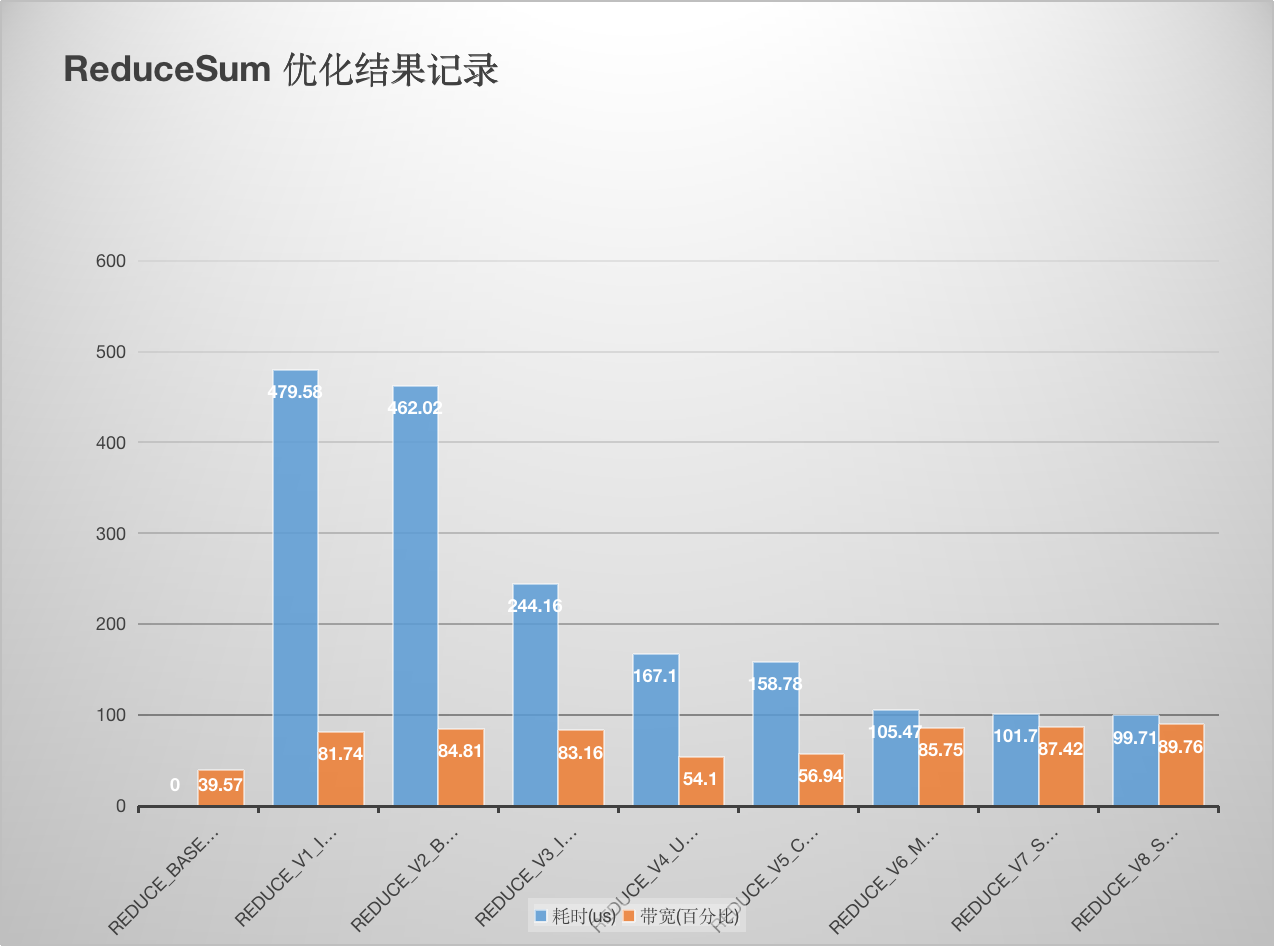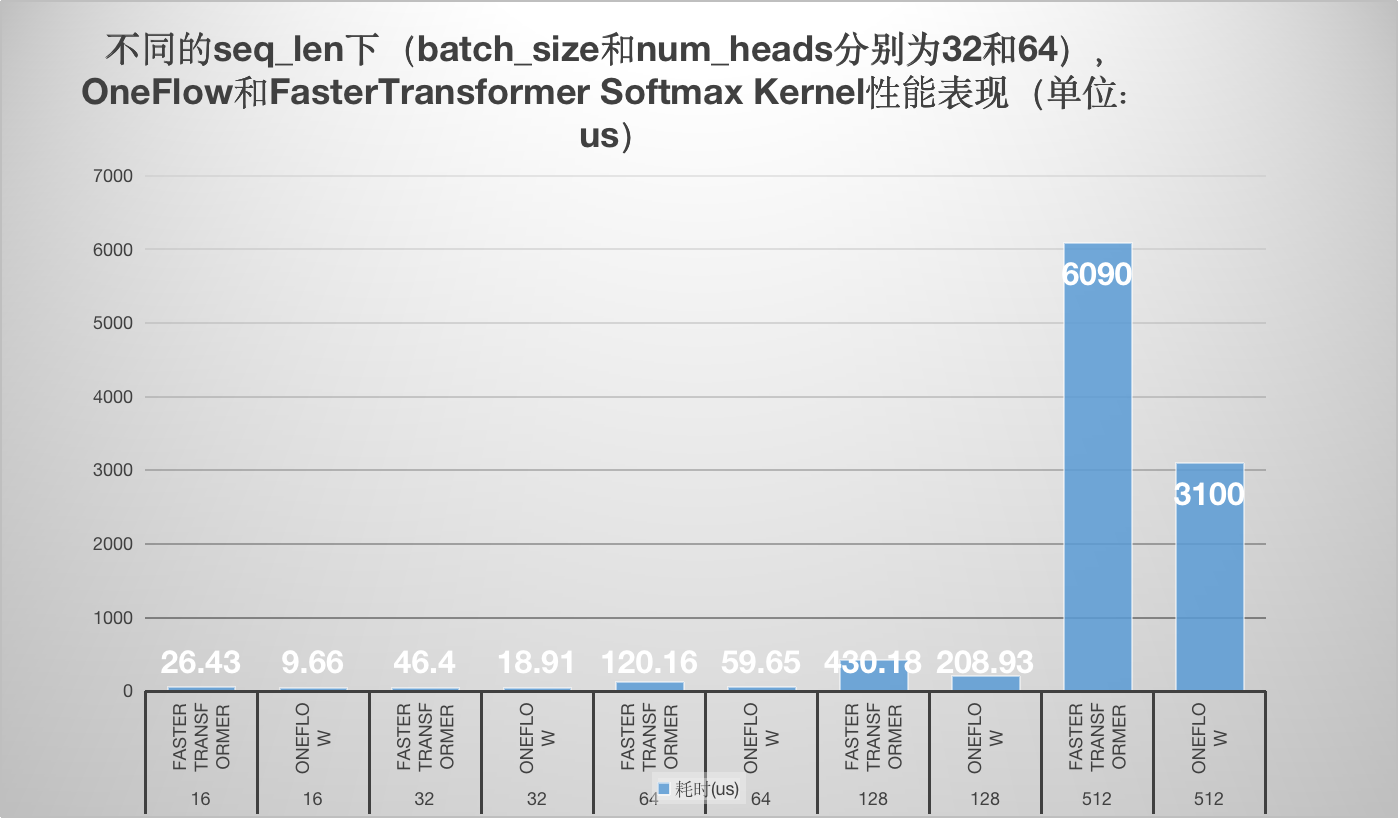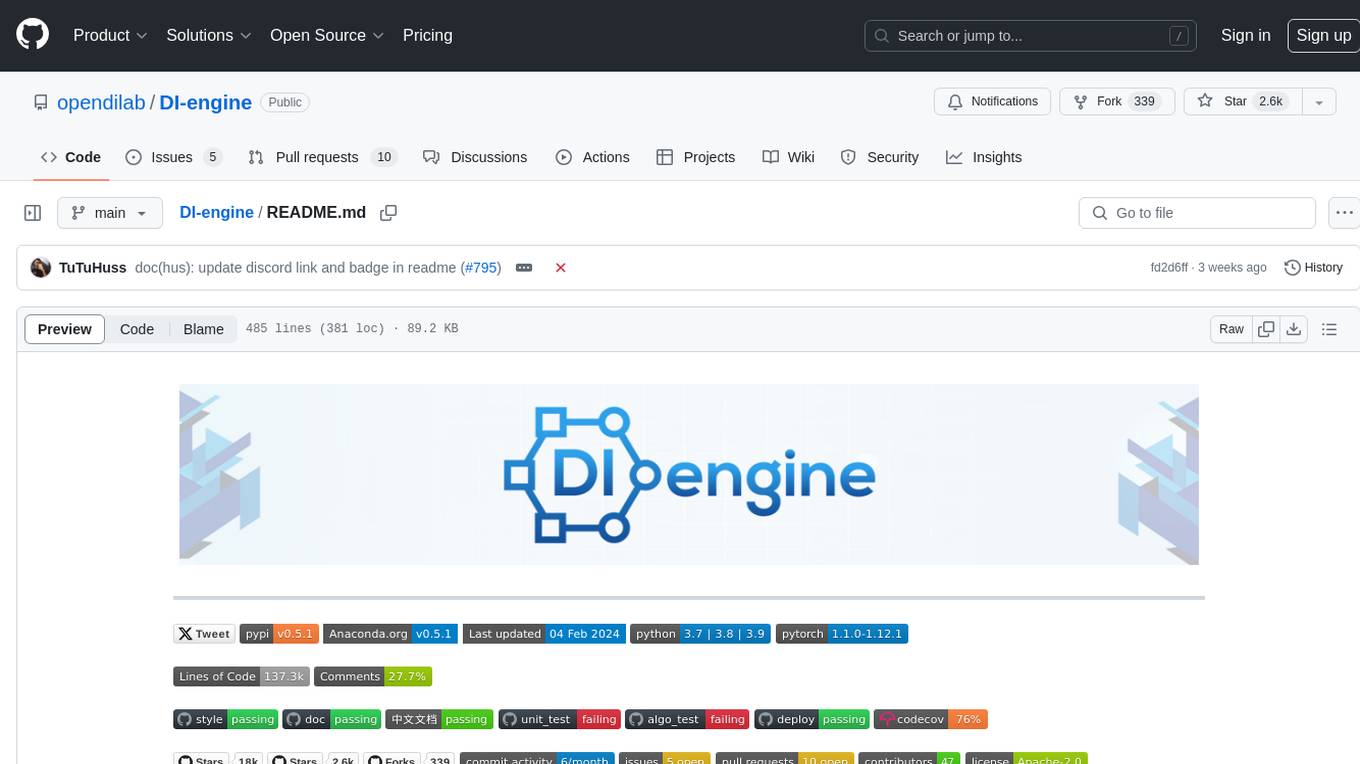
how-to-optim-algorithm-in-cuda
how to optimize some algorithm in cuda.
Stars: 2509
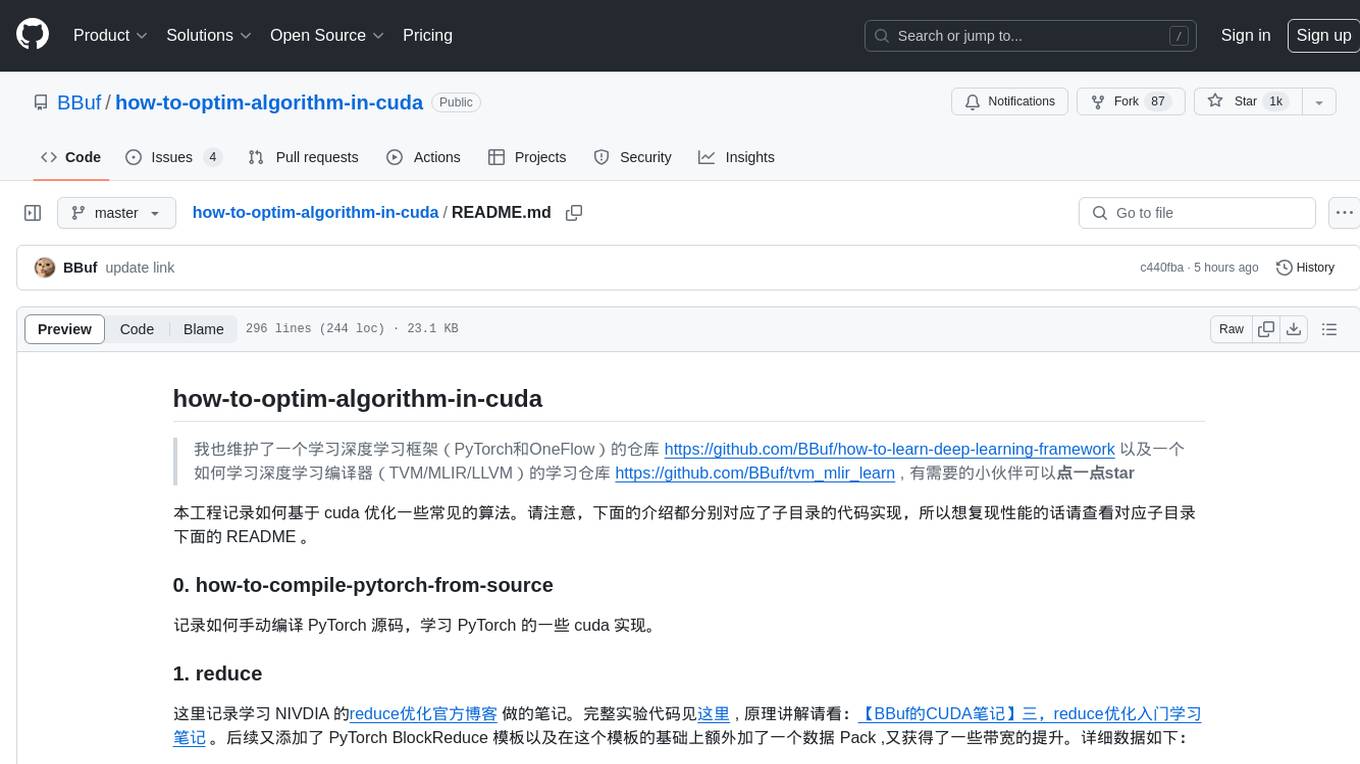
This repository documents how to optimize common algorithms based on CUDA. It includes subdirectories with code implementations for specific optimizations. The optimizations cover topics such as compiling PyTorch from source, NVIDIA's reduce optimization, OneFlow's elementwise template, fast atomic add for half data types, upsample nearest2d optimization in OneFlow, optimized indexing in PyTorch, OneFlow's softmax kernel, linear attention optimization, and more. The repository also includes learning resources related to deep learning frameworks, compilers, and optimization techniques.
README:
我也维护了一个学习深度学习框架(PyTorch和OneFlow)的仓库 https://github.com/BBuf/how-to-learn-deep-learning-framework 以及一个如何学习深度学习编译器(TVM/MLIR/LLVM)的学习仓库 https://github.com/BBuf/tvm_mlir_learn , 有需要的小伙伴可以点一点star
本工程记录如何基于 cuda 优化一些常见的算法。请注意,下面的介绍都分别对应了子目录的代码实现,所以想复现性能的话请查看对应子目录下面的 README 。
- 课程的 Slides 和 脚本:https://github.com/cuda-mode/lectures
- 课程地址:https://www.youtube.com/@CUDAMODE
- 我的课程笔记:https://github.com/BBuf/how-to-optim-algorithm-in-cuda/tree/master/cuda-mode
一直想系统看一下某个课程系统和科学的学习下 CUDA ,感觉 CUDA-MODE 这个课程能满足我的需求。这个课程是几个 PyTorch 的 Core Dev 搞的,比较系统和专业。不过由于这个课程是 Youtube 上的英语课程,所以要学习和理解这个课程还是需要花不少时间的,我这里记录一下学习这个课程的每一课的笔记,希望可以通过这个笔记帮助对这个课程以及 CUDA 感兴趣的读者更快吸收这个课程的知识。这个课程相比于以前的纯教程更加关注的是我们可以利用 CUDA 做什么事情,而不是让读者陷入到 CUDA 专业术语的细节中,那会非常痛苦。伟大无需多言,感兴趣请阅读本文件夹下的各个课程的学习笔记。
记录如何手动编译 PyTorch 源码,学习 PyTorch 的一些 cuda 实现。
这里记录学习 NIVDIA 的reduce优化官方博客 做的笔记。完整实验代码见这里 , 原理讲解请看:【BBuf的CUDA笔记】三,reduce优化入门学习笔记 。后续又添加了 PyTorch BlockReduce 模板以及在这个模板的基础上额外加了一个数据 Pack ,又获得了一些带宽的提升。详细数据如下:
性能和带宽的测试情况如下 (A100 PCIE 40G):
将 oneflow 的 elementwise 模板抽出来方便大家使用,这个 elementwise 模板实现了高效的性能和带宽利用率,并且用法非常灵活。完整实验代码见这里 ,原理讲解请看:【BBuf 的CUDA笔记】一,解析OneFlow Element-Wise 算子实现 。这里以逐点乘为例,性能和带宽的测试情况如下 (A100 PCIE 40G):
| 优化手段 | 数据类型 | 耗时(us) | 带宽利用率 |
|---|---|---|---|
| naive elementwise | float | 298.46us | 85.88% |
| oneflow elementwise | float | 284us | 89.42% |
| naive elementwise | half | 237.28us | 52.55% |
| oneflow elementwise | half | 140.74us | 87.31% |
可以看到无论是性能还是带宽,使用 oneflow 的 elementwise 模板相比于原始实现都有较大提升。
实现的脚本是针对half数据类型做向量的内积,用到了atomicAdd,保证数据的长度以及gridsize和blocksize都是完全一致的。一共实现了3个脚本:
- https://github.com/BBuf/how-to-optim-algorithm-in-cuda/blob/master/FastAtomicAdd/atomic_add_half.cu 纯half类型的atomicAdd。
- https://github.com/BBuf/how-to-optim-algorithm-in-cuda/blob/master/FastAtomicAdd/atomic_add_half_pack2.cu half+pack,最终使用的是half2类型的atomicAdd。
- https://github.com/BBuf/how-to-optim-algorithm-in-cuda/blob/master/FastAtomicAdd/fast_atomic_add_half.cu 快速原子加,虽然没有显示的pack,但本质上也是通过对单个half补0使用上了half2的原子加。
性能和带宽的测试情况如下 (A100 PCIE 40G):
| 原子加方式 | 性能(us) |
|---|---|
| 纯half类型 | 422.36ms |
| pack half2类型 | 137.02ms |
| fastAtomicAdd | 137.01ms |
可以看到使用pack half的方式和直接使用half的fastAtomicAdd方式得到的性能结果一致,均比原始的half的原子加快3-4倍。
upsample_nearest_2d.cu 展示了 oneflow 对 upsample_nearest2d 的前后向的优化 kernel 的用法,性能和带宽的测试情况如下 (A100 PCIE 40G):
| 框架 | 数据类型 | Op类型 | 带宽利用率 | 耗时 |
|---|---|---|---|---|
| PyTorch | Float32 | UpsampleNearest2D forward | 28.30% | 111.42us |
| PyTorch | Float32 | UpsampleNearest2D backward | 60.16% | 65.12us |
| OneFlow | Float32 | UpsampleNearest2D forward | 52.18% | 61.44us |
| OneFlow | Float32 | UpsampleNearest2D backward | 77.66% | 50.56us |
| PyTorch | Float16 | UpsampleNearest2D forward | 16.99% | 100.38us |
| PyTorch | Float16 | UpsampleNearest2D backward | 31.56% | 57.38us |
| OneFlow | Float16 | UpsampleNearest2D forward | 43.26% | 35.36us |
| OneFlow | Float16 | UpsampleNearest2D backward | 44.82% | 40.26us |
可以看到基于 oneflow upsample_nearest2d 的前后向的优化 kernel 可以获得更好的带宽利用率和性能。注意这里的 profile 使用的是 oneflow 脚本,而不是 upsample_nearest_2d.cu ,详情请看 UpsampleNearest2D/README.md 。
在 PyTorch 中对 index_add 做了极致的优化,我这里将 PyTorch 的 index_add 实现 进行了剥离,方便大家应用于其它框架。具体请看 indexing 文件夹的 README 。其中还有和 oneflow 的 index_add 实现的各个 case 的性能比较结果。整体来说 PyTorch 在 index Tensor元素很小,但Tensor很大的情况下有较大的性能提升,其它情况和 OneFlow 基本持平。详情请看 indexing/README.md 。
OneFlow 深度学习框架中基于 cuda 做的优化工作,动态更新中。
总结 FastTransformer 相关的 cuda 优化技巧。README_BERT.md 总结了 BERT 相关的优化技巧。
学习了oneflow的softmax kernel实现以及Faster Transformer softmax kernel的实现,并以个人的角度分别解析了原理和代码实现,最后对性能做一个对比方便大家直观的感受到oneflow softmax kernel相比于FasterTransformer的优越性。
学习一些 linear attention 的 cuda 优化技巧。
收集了和大语言模型原理,训练,推理,数据标注的相关文章。
前研的大模型训练相关 AI-Infra 论文收集以及阅读笔记。
Triton 学习过程中的代码记录和学习笔记。
Meagtron-LM 学习笔记。
Triton 中国举办的 Meetup 的slides汇总。点卡这个文件夹也可以找到对应的Meetup的视频回放。
对 CUDA PTX ISA 文档的一个翻译和学习。
对 PyTorch 团队发布的 cuda 技术的一些学习笔记。
cutlass 相关的学习笔记。
cuda 相关的 paper 的阅读。
点击展开/收起 BBuf 的 CUDA 学习笔记列表
- 【BBuf的CUDA笔记】一,解析OneFlow Element-Wise 算子实现
- 【BBuf的CUDA笔记】二,解析 OneFlow BatchNorm 相关算子实现
- 【BBuf的CUDA笔记】三,reduce优化入门学习笔记
- 【BBuf的CUDA笔记】四,介绍三个高效实用的CUDA算法实现(OneFlow ElementWise模板,FastAtomicAdd模板,OneFlow UpsampleNearest2d模板)
- 【BBuf的CUDA笔记】五,解读 PyTorch index_add 操作涉及的优化技术
- 【BBuf的CUDA笔记】六,总结 FasterTransformer Encoder(BERT) 的cuda相关优化技巧
- 【BBuf的CUDA笔记】七,总结 FasterTransformer Decoder(GPT) 的cuda相关优化技巧
- 【BBuf的CUDA笔记】八,对比学习OneFlow 和 FasterTransformer 的 Softmax Cuda实现
- 【BBuf的CUDA笔记】九,使用newbing(chatgpt)解析oneflow softmax相关的fuse优化
- CodeGeeX百亿参数大模型的调优笔记:比FasterTransformer更快的解决方案
- 【BBuf的cuda学习笔记十】Megatron-LM的gradient_accumulation_fusion优化
- 【BBuf的CUDA笔记】十,Linear Attention的cuda kernel实现解析
- 【BBuf的CUDA笔记】十一,Linear Attention的cuda kernel实现补档
- 【BBuf的CUDA笔记】十二,LayerNorm/RMSNorm的重计算实现
- 【BBuf的CUDA笔记】十三,OpenAI Triton 入门笔记一
- 【BBuf的CUDA笔记】十四,OpenAI Triton入门笔记二
- 【BBuf的CUDA笔记】十五,OpenAI Triton入门笔记三 FusedAttention
- AI Infra论文阅读之通过打表得到训练大模型的最佳并行配置
- AI Infra论文阅读之将流水线并行气泡几乎降到零(附基于Meagtron-LM的ZB-H1开源代码实现解读)
- AI Infra论文阅读之LIGHTSEQ(LLM长文本训练的Infra工作)
- AI Infra论文阅读之《在LLM训练中减少激活值内存》
- 系统调优助手,PyTorch Profiler TensorBoard 插件教程
- 在GPU上加速RWKV6模型的Linear Attention计算
- flash-linear-attention的fused_recurrent_rwkv6 Triton实现精读
- flash-linear-attention中的Chunkwise并行算法的理解
- 硬件高效的线性注意力机制Gated Linear Attention论文阅读
- GQA,MLA之外的另一种KV Cache压缩方式:动态内存压缩(DMC)
- vAttention:用于在没有Paged Attention的情况下Serving LLM
- 大模型KV Cache节省神器MLA学习笔记(包含推理时的矩阵吸收分析)
- CUDA-MODE 课程笔记 第一课: 如何在 PyTorch 中 profile CUDA kernels
- CUDA-MODE 第一课课后实战(上)
- CUDA-MODE 第一课课后实战(下)
- CUDA-MODE 课程笔记 第二课: PMPP 书的第1-3章速通
- CUDA-MODE 课程笔记 第四课: PMPP 书的第4-5章笔记
- CUDA-MODE课程笔记 第6课: 如何优化PyTorch中的优化器
- CUTLASS 2.x & CUTLASS 3.x Intro 学习笔记
- CUDA-MODE课程笔记 第7课: Quantization Cuda vs Triton
- TRT-LLM中的Quantization GEMM(Ampere Mixed GEMM)CUTLASS 2.x 课程学习笔记
- CUDA-MODE课程笔记 第8课: CUDA性能检查清单
- TensorRT-LLM 中的 Hopper Mixed GEMM 的 CUTLASS 3.x 实现讲解
- 通过微基准测试和指令级分析(Instruction-level Analysis)揭秘英伟达Ampere架构
- CUDA-MODE课程笔记 第9课: 归约(也对应PMPP的第10章)
- 【翻译】Accelerating Llama3 FP8 Inference with Triton Kernels
- 【PyTorch 奇淫技巧】Python Custom Operators翻译
- 【翻译】教程:在PyTorch中为CUDA库绑定Python接口
- 【翻译】教程:CUTLASS中的矩阵转置 (使用CuTe把矩阵转置优化到GPU内存带宽上下限)
- CUDA-MODE课程笔记 第11课: Sparsity
- 【PyTorch 奇淫技巧】Async Checkpoint Save
- CUDA-MODE课程笔记 第12课,Flash Attention
- 【翻译】在 GPU 上如何加速 GPTQ Triton 反量化kernel
- 基于o1-preview解读 Optimized GPTQ INT4 Dequantization Triton Kernel
- 【翻译】深入探讨 Hopper TMA 单元在 FP8 GEMM 运算中的应用
- 【翻译】CUTLASS 教程:掌握 NVIDIA® 张量内存加速器 (TMA)
- 【PyTorch 奇技淫巧】介绍 depyf:轻松掌握 torch.compile
- CUDA-MODE 课程笔记 第13课:Ring Attention
- 【翻译】torch.compile 的详细示例解析教程
- 【翻译】【PyTorch 奇技淫巧】FlexAttetion 基于Triton打造灵活度拉满的Attention
- Flex Attention API 应用 Notebook 代码速览
- 【翻译】CUDA-Free Inference for LLMs
- CUDA-MODE 课程笔记 第14课,Triton 实践指南
- 【翻译】使用PyTorch FSDP最大化训练吞吐量
- 【翻译】使用PyTorch FSDP和Torch.compile最大化训练吞吐量
- 【ml-engineering 翻译系列】大模型推理
- 【ml-engineering 翻译系列】AI系统中的网络概述
- 【ml-engineering 翻译系列】AI系统中的网络 debug
- 【ml-engineering 翻译系列】AI系统中的网络 benchmark
- 【翻译】在FSDP2中开启Float8 All-Gather
- 【ml-engineering 翻译系列】训练之模型并行
- 梳理下Flash Attention的dispatch逻辑
- 【ml-engineering 翻译系列】计算加速器之cpu
- CUDA-MODE课程笔记 Lecture 16 通过CUDA C++核心库把llm.c移植为llm.cpp
- GPU 矩阵乘实际可达最大FLOPS测量工具
- CUDA-MODE 课程笔记 第28课 用在生产环境中的LinkedIn Liger kernel
- RMSNorm的精度陷阱:记一次LLM推理精度调查
- 如何正确理解NVIDIA GPU利用率的概念
- CUDA-MODE 课程笔记 第29课 Triton内部机制
- GTX 4090 的 cuda graph 诡异
- 【ml-engineering 翻译系列】计算加速器之gpu
- CUDA-MODE课程笔记 第17课 GPU集合通信(NCCL)
- Triton Kernel 编译阶段
- 使用torchtune把LLaMa-3.1 8B蒸馏为1B
- [分布式训练与TorchTitan] PyTorch中的Async Tensor Parallelism介绍
- PyTorch 博客 CUTLASS Ping-Pong GEMM Kernel 简介
- PyTorch博客 《使用 Triton 加速 2D 动态块量化 Float8 GEMM 简介》
- 使用NCU和Cursor Claude-sonnet-3.5写出高效cuda算子的正确姿势
- Fused AllGather_MatMul Triton工程实现
- MoE之年的总结和MoE 推理优化的一些认识
- SGLang DP MLA 特性解读
- Windsurf(可平替 Cursor) 的使用体验和技巧
- SGLang MLA 实现解析
- 详解vLLM和SGLang awq dequantize kernel的魔法
- SGLang 支持Flash Attention V3 Backend
- 分享一个DeepSeek V3和R1中 Shared Experts和普通Experts融合的一个小技巧
- CUDA优化 让向量求和变得非常快
- DeepSeek-V3 + SGLang: 推理优化 (v0.4.3.post2+sgl-kernel:0.0.3.post6)
- 图解DeepSeek V3 biased_grouped_topk cuda融合算子fused_moe_gate kernel
- 一起聊聊Nvidia Hopper 新特性之TMA
- 一起聊聊Nvidia Hopper新特性之WGMMA
- 一起聊聊Nvidia Hopper新特性之Pipeline
- 一起聊聊Nvidia Hopper新特性之计算切分
- 【博客翻译】CUDA中的索引
- 图解Vllm V1系列1:整体流程
- 在 SGLang 中实现 Flash Attention 后端 - 基础和 KV 缓存
- 图解Vllm V1系列2:Executor-Workers架构
- 【博客翻译】让前缀和变得更快
- SGLang Team:在 96 个 H100 GPU 上部署具有 PD 分解和大规模专家并行性的 DeepSeek
- 图解Vllm V1系列3:KV Cache初始化
- 【CUDA 优化】让RMSNorm变得更快
- 在SGLang中使用reasoning模型
- SGLang 源码学习笔记:Cache、Req与Scheduler
- 单机H200最快DeepSeek V3和R1推理系统优化秘籍
- 通过查看GPU Assembly分析CUDA程序
- sglang 源码学习笔记(二)- backend & forward 过程
- Sglang 源码学习笔记(三)- 分布式和并行(以deepseek 为例)(WIP)
- 【CUDA 博客】TMA简介 & 让矩阵转置在Hopper GPUs上变得更快
点击展开/收起 CUDA优质博客列表
- Writing my own communications library - a worklog of creating Penny part 1
- CuteDSL-1: Introduction
- Enable Tensor Core Programming in Python with CUTLASS 4.0
- 一文读懂nvidia-smi topo的输出
- 如果你是一个C++面试官,你会问哪些问题?
- 推理部署工程师面试题库
- [C++特性]对std::move和std::forward的理解
- 论文阅读:Mimalloc Free List Sharding in Action
- 在 C++ 中,RAII 有哪些妙用?
- AI/HPC面试问题整理
- Roofline Model与深度学习模型的性能分析
- FlashAttention核心逻辑以及V1 V2差异总结
- flash attention 1和flash attention 2算法的python和triton实现
- Flash Attention 推公式
- 图解大模型计算加速系列:FlashAttention V1,从硬件到计算逻辑
- flash attention完全解析和CUDA零基础实现
- FlashAttention图解(如何加速Attention)
- FlashAttention:加速计算,节省显存, IO感知的精确注意力
- FlashAttention 反向传播运算推导
- 比标准Attention提速5-9倍,大模型都在用的FlashAttention v2来了
- FlashAttention 的速度优化原理是怎样的?
- FlashAttention 的速度优化原理是怎样的?
- FlashAttention2详解(性能比FlashAttention提升200%)
- FlashAttenion-V3: Flash Decoding详解
- 速通PageAttention2
- PageAttention代码走读
- 大模型推理加速之FlashDecoding++:野生Flash抵达战场
- 学习Flash Attention和Flash Decoding的一些思考与疑惑
- 大模型推理加速之Flash Decoding:更小子任务提升并行度
- FlashAttention与Multi Query Attention
- 动手Attention优化1:Flash Attention 2优化点解析
- Flash Attention推理性能探究
- 记录Flash Attention2-对1在GPU并行性和计算量上的一些小优化
- [LLM] FlashAttention 加速attention计算[理论证明|代码解读]
- FlashAttention核心逻辑以及V1 V2差异总结
- 【手撕LLM-FlashAttention】从softmax说起,保姆级超长文!!
- 动手Attention优化2:图解基于PTX的Tensor Core矩阵分块乘法实现
- flash attention 的几个要点
- GPU内存(显存)的理解与基本使用
- 图文并茂,超详细解读nms cuda拓展源码
- 大模型的好伙伴,浅析推理加速引擎FasterTransformer
- LLM Inference CookBook(持续更新)
- NVIDIA的custom allreduce
- [论文速读] FlashAttention: Fast and Memory-Efficient Exact Attention with IO-Awareness
- CUDA随笔之Stream的使用
- 简单读读FasterTransformer
- cutlass FusedMultiheadAttention代码解读
- 简单谈谈CUDA Reduce
- GridReduce - CUDA Reduce 部分结果归约
- CUTLASS: Fast Linear Algebra in CUDA C++
- cutlass源码导读(1)——API与设计理念
- cutlass源码导读(2)——Gemm的计算流程
- CUDA GroupNorm NHWC优化
- 传统 CUDA GEMM 不完全指北
- 怎么评估内存带宽的指标,并进行优化?
- TensorRT Diffusion模型优化点
- NVIDIA GPU性能优化基础
- 一文理解 PyTorch 中的 SyncBatchNorm
- 如何开发机器学习系统:高性能GPU矩阵乘法
- CUDA SGEMM矩阵乘法优化笔记——从入门到cublas
- Dropout算子的bitmask优化
- 面向 Tensor Core 的算子自动生成
- PICASSO论文学习
- CUDA翻译:How to Access Global Memory Efficiently in CUDA C/C++ Kernels
- CUDA Pro Tips翻译:Write Flexible Kernels with Grid-Stride Loops
- [施工中] CUDA GEMM 理论性能分析与 kernel 优化
- CUDA Ampere Tensor Core HGEMM 矩阵乘法优化笔记 —— Up To 131 TFLOPS!
- Nvidia Tensor Core-CUDA HGEMM优化进阶
- CUDA C++ Best Practices Guide Release 12.1笔记(一)
- CUDA 矩阵乘法终极优化指南
- 如何用CUDA写有CuBLAS 90%性能的GEMM Kernel
- 如何理解Nvidia英伟达的Multi-GPU多卡通信框架NCCL?
- 如何理解Nvidia英伟达的Multi-GPU多卡通信框架NCCL?
- 如何理解Nvidia英伟达的Multi-GPU多卡通信框架NCCL?
- 使用FasterTransformer实现LLM分布式推理
- 细粒度GPU知识点详细总结
- https://siboehm.com/articles/22/CUDA-MMM
- 【CUDA编程】OneFlow Softmax算子源码解读之BlockSoftmax
- 【CUDA编程】OneFlow Softmax 算子源码解读之WarpSoftmax
- 【CUDA编程】OneFlow Element-Wise 算子源码解读
- 【CUDA编程】Faster Transformer v1.0 源码详解
- 【CUDA编程】Faster Transformer v2.0 源码详解
- FasterTransformer Decoding 源码分析(七)-FFNLayer MoE(上篇)
- FasterTransformer Decoding 源码分析(八)-FFNLayer MoE(下篇)
- 从roofline模型看CPU矩阵乘法优化
- 性能优化的终极手段之 Profile-Guided Optimization (PGO)
- 有没有大模型推理加速引擎FasterTransformer入门级教程?
- 深入浅出GPU优化系列:gemv优化
- NVIDIA Hopper架构TensorCore分析(4)
- GPU host+device的编译流程
- Tensor Core 优化半精度矩阵乘揭秘
- 无痛CUDA实践:μ-CUDA 自动计算图生成
- CUDA(三):通用矩阵乘法:从入门到熟练
- 自己写的CUDA矩阵乘法能优化到多快?
- 高效CUDA Scan算法浅析
- 一次 CUDA Graph 调试经历
- CUDA中的radix sort算法
- NVIDIA Tensor Core微架构解析
- cutlass cute 101
- 在GPU避免分支的方法
- Pytorch-CUDA从入门到放弃(二)
- 腾讯机智团队分享--AllReduce算法的前世今生
- cute 之 Layout
- cute Layout 的代数和几何解释
- cute 之 GEMM流水线
- Using CUDA Warp-Level Primitives
- CUDA Pro Tip: Increase Performance with Vectorized Memory Access
- cute 之 简单GEMM实现
- cute 之 MMA抽象
- cute 之 Tensor
- cute Swizzle细谈
- 基于 CUTE 的 GEMM 优化【2】—— 高效 GEMM 实现,超越 Cublas 20%
- CUDA单精度矩阵乘法(sgemm)优化笔记
- HPC(高性能计算第一篇) :一文彻底搞懂并发编程与内存屏障(第一篇)
- GPU CUDA 编程的基本原理是什么? 怎么入门?
- 如何入门 OpenAI Triton 编程?
- CUDA(二):GPU的内存体系及其优化指南
- nvitop: 史上最强GPU性能实时监测工具
- 使用Triton在模型中构建自定义算子
- CUDA笔记 内存合并访问
- GPGPU架构,编译器和运行时
- GPGPU的memory 体系理解
- nvlink那些事……
- 对NVidia Hopper GH100 的一些理解
- 黑科技:用cutlass进行低成本、高性能卷积算子定制开发
- 乱谈Triton Ampere WMMA (施工中)
- 可能是讲的最清楚的WeightonlyGEMM博客
- GPU 底层机制分析:kernel launch 开销
- GPU内存(显存)的理解与基本使用
- 超越AITemplate,打平TensorRT,SD全系列模型加速框架stable-fast隆重登场
- [手把手带你入门CUTLASS系列] 0x00 cutlass基本认知---为什么要用cutlass
- [手把手带你入门CUTLASS系列] 0x02 cutlass 源码分析(一) --- block swizzle 和 tile iterator (附tvm等价code)
- [手把手带你入门CUTLASS系列] 0x03 cutlass 源码分析(二) --- bank conflict free 的shared memory layout (附tvm等价pass)
- [深入分析CUTLASS系列] 0x04 cutlass 源码分析(三) --- 多级流水线(software pipeline)
- [深入分析CUTLASS系列] 0x03 cutlass 源码分析(二) --- bank conflict free 的shared memory layout (附tvm等价pass)
- GPU 内存概念浅析
- NV_GPU tensor core 算力/带宽/编程模型分析
- Nsight Compute - Scheduler Statistics
- NVidia GPU指令集架构-前言
- 搞懂 CUDA Shared Memory 上的 bank conflicts 和向量化指令(LDS.128 / float4)的访存特点
- 窥探Trition的lower(二)
- 窥探Trition的lower(三)
- ops(2):SoftMax 算子的 CUDA 实现与优化
- cuda学习日记(6) nsight system / nsight compute
- ops(3):Cross Entropy 的 CUDA 实现
- cuda的ldmatrix指令的详细解释
- 揭秘 Tensor Core 底层:如何让AI计算速度飞跃
- NCCL(NVIDIA Collective Communication Library)的来龙去脉
- ldmatrix与swizzle(笔记)
- GPU上GEMM的边界问题以及优化
- NV Tensor Core and Memory Accelerator 理论分析
- CUTLASS CuTe GEMM细节分析(一)——ldmatrix的选择
- Triton到PTX(1):Elementwise
- 由矩阵乘法边界处理引起的CUDA wmma fragment与原始矩阵元素对应关系探究
- NVIDIA Hopper架构TensorCore分析(4)
- NVidia GPU指令集架构-Load和Cache
- NVidia GPU指令集架构-寄存器
- Async Copy 及 Memory Barrier 指令的功能与实现
- tensorcore中ldmatrix指令的优势是什么?
- 使用cutlass cute复现flash attention
- 1. Cuda矩阵乘法GeMM性能优化
- 一步步优化 GEMM by Tensorcore
- CUTLASS 3.x 异构编程随感
- Triton到PTX(1):Elementwise
- Triton到SASS(2):Reduction
- cuda的ldmatrix指令的详细解释
- 基于 CuTe 理解 swizzle, LDSM, MMA
- 一文读懂nsight system与cuda kernel的时间线分析与可视化
- TileLang: 80行Python kernel代码实现FlashMLA 95%的性能
- 简单CUDA Assembly介绍
- Deep Gemm 代码浅析
- 如何看懂deepseek ai开源的FlashMLA中的核心cu代码?
- 浅析GEMM优化multistage数怎么算
- DeepSeek: FlashMLA代码解析
- triton(openai)如何实现splitk和streamk?
- FlashMLA性能简测
- DeepSeek-V3/R1 的 Hosting 成本预估
- 实用 Swizzle 教程(一)
- 实用 Swizzle 教程(二)
- CUDA编程入门之Cooperative Groups(1)
- Flash Attention 3 深度解析
- flashattention中为什么Br的分块要取min,Bc除以4我理解是M要装下QKVO,Br呢?
- FlashAttention笔记
- 由GQA性能数据异常引发的对MHA,GQA,MQA 在GPU上的感性分析
- 动手Attention优化3:理解Bank Conflict及Cutlass Swizzle
- 如何理解GPU Kernel Grid/Block与SM占用率的关系?什么是Tail Effect?
- Triton入门笔记(二):flash attention的Triton/CUDA对比(前向传播部分)
- 基于 CuTe 理解 swizzle, LDSM, MMA
- NCCL通信C++示例(四): AlltoAll_Split实现与分析
- 如何用 Triton实现一个更高效的topk_gating kernel?——算子合并技术
- 关于Nsight Compute中Compute Workload Analysis反映的Tensor Pipe Utilization的理解
- MARLIN: Mixed-Precision Auto-Regressive Parallel Inference on Large Language Models论文解读
- Shader中的条件分支能否节省shader的性能?
- LLM Decode GQA & GEMV算子性能分析(一)
- LLM Decode GQA & GEMV算子性能分析(二)
- cute gemm 优化
- [Triton] Triton-Linalg
- cutlass swizzle机制解析(一)
- vLLM源码之PageAttention
- CUTLASS CUTE MMA
- 了解FlashAttentionV3的优化需要先了解Hopper的主要技术(Hopper White Paper概述)
- 从Hopper架构到HGEMM
- 基于CUTLASS CuTe分析cp.async的Prefetch行为
- 为什么加pad可以解bank conflict?
- cute swizzle
- CUTLASS CuTe GEMM细节分析(三)——Swizzle<B, M, S>模板参数的取值
- OpenAI Triton: Why layout is important
- Triton到SASS(5.5):TMA/Multicast/Warp Specialize踩坑记
- Tile-lang 简介
- CUTLASS:基于CUTE的矩阵乘法优化
- Marlin W4A16&W4A8代码走读
- CUTLASS 3: CuTe Layout Algebra
点击展开/收起 大模型Infra优质博客列表
- Megatron-LM 分布式执行调研
- BLOOM 训练背后的技术
- 聊聊 PyTorch2.0 中新的Distributed API
- 聊聊 PyTorch 中新的Distributed API (二)
- 【LLM】从零开始训练大模型
- 在一张 24 GB 的消费级显卡上用 RLHF 微调 20B LLMs
- 人手一个ChatGPT!微软DeepSpeed Chat震撼发布,一键RLHF训练千亿级大模型
- 大型语言模型(LLM)训练指南🚀
- “StackLLaMA”: 用 RLHF 训练 LLaMA 的手把手教程
- 图解大模型训练之:流水线并行(Pipeline Parallelism),以Gpipe为例
- 图解大模型训练之:数据并行上篇(DP, DDP与ZeRO)
- 图解大模型训练之:数据并行下篇( DeepSpeed ZeRO,零冗余优化)
- 图解大模型训练之:张量模型并行(TP),Megatron-LM
- Megatron-LM 中的 pipeline 并行
- 图解大模型系列之:Megatron源码解读1,分布式环境初始化
- 图解大模型训练之:Megatron源码解读2,模型并行
- 聊聊序列并行Sequence parallelism
- 深入理解 Megatron-LM(1)基础知识
- 深入理解 Megatron-LM(2)原理介绍
- 深入理解 Megatron-LM(3)代码结构
- 深入理解 Megatron-LM(4)并行设置
- 深入理解 Megatron-LM(5)张量并行
- 聊聊字节 AML 万卡工作 MegaScale: Scaling Large Language Model Training
- 深度学习里,模型并行中怎么将模型拆分?
- Transformers DeepSpeed官方文档
- DeepSeek-V3 MTP 工程实现思考
- DeepSeek V3/R1 推理效率分析(1):关于DeepSeek V3/R1 Decoding吞吐极限的一些不负责任估计
- DeepSeek V3/R1 推理效率分析(2): DeepSeek 满血版逆向工程分析
- DeepSeek V3/R1 推理效率分析(3):Decode 配置泛化讨论
- 如何估算不同规格的芯片 EP 部署 Deepseek 的单卡吞吐 V1.0
- 深度解析FlashMLA: 一文读懂大模型加速新利器
- Flash MLA 笔记
- MoE Inference On AnyScale
- 大模型分布式通信技术博客汇总
- sglang 源码学习笔记(一)- Cache、Req与Scheduler
- DualPipe 深入浅出:没有分布式训练基础也能看懂的 DualPipe 全方位讲解
- DeepSeek MLA引发的一些记忆碎片
- DeepSeek MLA的序列并行和张量并行
- SGLang: Triton算子extend_attention/Prefix优化
- DeepSeek-V3 (671B) 模型参数量分解计算
- DeepSeek关键技术再总结
- PP->VPP->ZeroBubblePP->deepseekv3 dualPipe,对PP bubble的极致压缩
- 双流并行(DualPipe) 没有双流会更好
- deepseek 训练 profile data 基础分析
- Deepseek FlashMLA解析
- 理解DeepGEMM源码和实现逻辑
- DeepEP Dispatch/Combine 图示
- MoE并行负载均衡:EPLB的深度解析与可视化
- 给 Megatron 的长文本训练抓了一个 Bug
- 对DualPipe的一些想法
- SGLang: Triton算子prefill_attention
- [CUDA基础]📚CUDA-Learn-Notes: v3.0 大升级-面试刷题不迷路
- [大模型推理系统] SGlang的异步调度:Overlap CPU和GPU流水
- 计算DeepSeekV3训练的MFU
- 如何评价 DeepSeek 的 DeepSeek-V3 模型?
- SGLang _fwd_kernel_stage2 计算公式推导
- SGLang代码快速上手(with openRLHF)
- DiT并行推理引擎-xDiT的设计哲学
- 记一次对 SGLang weight update latency 的优化
- vllm代码快速上手
- 由Ring-Attention性能问题引发的计算通信overlap分析
- TensorRT-LLM的allreduce插件
- DeepSeek-V2 MLA KV Cache 真的省了吗?
- PyTorch FSDP 设计解读
- 大模型推理-5-大模型推理优化之缓存及调度
- 【22token/s|又提升20%】榨干ktransformers的每一滴性能
- 从零开始设计SGLang的KV Cache
- LLM(33):MoE 的算法理论与 EP 的工程化问题
- Megatron中的MoE TokenDispatcher机制
- KTransformers v0.2.4: 多并发支持(上万行代码的诚意更新),Xeon6+MRDIMM 加持下单机单卡环境下四并发超过 40 tokens/s
- 从零开始的verl框架解析
- [AI Infra] VeRL 框架入门&代码带读
- 【AI Infra】【RLHF框架】一、VeRL中基于Ray的执行流程源码解析
- 【AI Infra】【RLHF框架】二、VeRL中colocate实现源码解析
- 【AI Infra】【RLHF框架】三、VeRL中的Rollout实现源码解析
- SGLang-veRL Server:从 Engine 到 Server,我们需要更灵活的 RLHF rollout 接口
- vLLM V1 源码阅读
- veRL框架初探
点击展开/收起 大模型和AIGC的演进
- github仓库
- rwkv论文原理解读
- RWKV的微调教学,以及RWKV World:支持世界所有语言的生成+对话+任务+代码
- RWKV:用RNN达到Transformer性能,且支持并行模式和长程记忆,既快又省显存,已在14B参数规模检验
- 谈谈 RWKV 系列的 prompt 设计,模型选择,解码参数设置
- RWKV进展:一键生成论文,纯CPU高速INT4,纯CUDA脱离pytorch,ctx8192不耗显存不变慢
- 开源1.5/3/7B中文小说模型:显存3G就能跑7B模型,几行代码即可调用
- 发布几个RWKV的Chat模型(包括英文和中文)7B/14B欢迎大家玩
- 实例:手写 CUDA 算子,让 Pytorch 提速 20 倍(某特殊算子)
- BlinkDL/RWKV-World-7B gradio demo
- ChatRWKV(有可用猫娘模型!)微调/部署/使用/训练资源合集
- pengbo的专栏
- RWKV 模型解析
- [线性RNN系列] Mamba: S4史诗级升级
- 状态空间模型: RWKV & Mamba
- Transformer,SSM,Linear Attention的联系与理解
- mixture-of-experts-with-expert-choice
- MoE训练论文解读之Megablocks:打破动态路由限制
- MoE训练论文解读之Tutel: 动态切换并行策略实现动态路由
- ACM SIGCOMM 2023有哪些亮点?
- LLM终身学习的可能性——Mixture of Experts
- MoE 入门介绍 核心工作回顾 模型篇
- 大语言模型结构之:浅谈MOE结构
- 训不动Mixtral,要不试试LLaMA-MoE?
- Mixtral-8x7B MoE大模型微调实践,超越Llama2-65B
- Mixtral-8x7B 模型挖坑
- Mixture of Experts(MoE)学习笔记
- 群魔乱舞:MoE大模型详解
- Mixtral 8x7B论文终于来了:架构细节、参数量首次曝光
- MoE(Mixture-of-Experts)大模型架构的优势是什么?为什么?
- 图解大模型训练系列之:DeepSpeed-Megatron MoE并行训练(原理篇
- 图解大模型训练系列之:DeepSpeed-Megatron MoE并行训练(源码解读篇)
- LLM 学习笔记-Deepspeed-MoE 论文
- 图解Mixtral 8 * 7b推理优化原理与源码实现
- 压缩下一个 token 通向超过人类的智能
- LLM 入门笔记-Tokenizer
- 【Transformer 基础系列】手推显存占用
- 《A Survey of Large Language Models》笔记
- 分析transformer模型的参数量、计算量、中间激活、KV cache
- Transformer模型的基础演算
- Transformer 估算 101
- 通向AGI之路:大型语言模型(LLM)技术精要
- Transformer学习笔记二:Self-Attention(自注意力机制)
- Transformer学习笔记三:为什么Transformer要用LayerNorm/Batch Normalization & Layer Normalization (批量&层标准化)
- Transformer学习笔记五:Subword Tokenization(子词分词器)
- ChatGPT技术解析系列之:GPT1、GPT2与GPT3
- ChatGPT技术解析系列之:训练框架InstructGPT
- ChatGPT技术解析系列之:赋予GPT写代码能力的Codex
- 大模型推理性能优化之KV Cache解读
- 拆解追溯 ChatGPT各项能力的起源
- ChatGPT 的突现能力,我们是否真的面临范式转变?
- 复杂推理:大型语言模型的"北极星"能力
- 深入理解NLP Subword算法:BPE、WordPiece、ULM
- ChatGPT 背后的“功臣”——RLHF 技术详解
- 深入浅出,解析ChatGPT背后的工作原理
- 这是Meta版ChatGPT雏形?开源、一块GPU就能跑,1/10参数量打败GPT-3
- LLaMA模型惨遭泄漏,Meta版ChatGPT被迫「开源」!GitHub斩获8k星,评测大量出炉
- LeCun狂赞:600刀GPT-3.5平替! 斯坦福70亿参数「羊驼」爆火,LLaMA杀疯了
- LeCun转赞:在苹果M1/M2芯片上跑LLaMA!130亿参数模型仅需4GB内存
- Stanford Alpaca (羊驼):ChatGPT 学术版开源实现
- Alpaca-Lora (羊驼-Lora): 轻量级 ChatGPT 的开源实现(对标 Standford Alpaca)
- Alpaca-cpp(羊驼-cpp): 可以本地运行的 Alpaca 大语言模型
- NLP(九):LLaMA, Alpaca, ColossalChat 系列模型研究
- 全球最大ChatGPT开源平替来了!支持35种语言,写代码、讲笑话全拿捏
- 国产ChatGPT又开源了!效果大幅升级,在手机上也可以跑
- 世界首款真开源类ChatGPT大模型Dolly 2.0,可随意修改商用
- 用ChatGPT训练羊驼:「白泽」开源,轻松构建专属模型,可在线试玩
- 3090单卡5小时,每个人都能训练专属ChatGPT,港科大开源LMFlow
- 300美元复刻ChatGPT九成功力,GPT-4亲自监考,130亿参数开源模型「小羊驼」来了
- 学术专用版ChatGPT火了,一键完成论文润色、代码解释、报告生成
- 笔记本就能运行的ChatGPT平替来了,附完整版技术报告
- 训练个中文版ChatGPT没那么难:不用A100,开源Alpaca-LoRA+RTX 4090就能搞定
- 弥补斯坦福70亿参数「羊驼」短板,精通中文的大模型来了,已开源
- 还在为玩不了ChatGPT苦恼?这十几个开源平替也能体验智能对话
- 斯坦福70亿参数开源模型媲美GPT-3.5,100美元即可复现
- 真·ChatGPT平替:无需显卡,MacBook、树莓派就能运行LLaMA
- ChatGPT开源替代来了!参数量200亿,在4300万条指令上微调而成
- B站UP主硬核自制智能音箱:有ChatGPT加持,才是真・智能
- 熔岩羊驼LLaVA来了:像GPT-4一样可以看图聊天,无需邀请码,在线可玩
- 3天近一万Star,无差体验GPT-4识图能力,MiniGPT-4看图聊天、还能草图建网站
- ChatGPT 中文调教指南。各种场景使用指南。学习怎么让它听你的话
- ChatGPT提示工程师|AI大神吴恩达教你写提示词
- [分析] 浅谈ChatGPT的Tokenizer
- OPT-175B是如何炼成的
- Meta复刻GPT-3“背刺”OpenAI,完整模型权重及训练代码全公开
- Limitations of LLaMA
- Hugging News #0506: StarCoder, DeepFloyd/IF 好多新的重量级模型
- StarCoder: 最先进的代码大模型
- VideoChat🦜: 基于视频指令数据微调的聊天机器人
- MiniGPT-4 本地部署 RTX 3090
- 更擅长推理的LLaMA大模型,支持中文!
- 点击鼠标,让ChatGPT更懂视觉任务!
- [分析] ROPE的不同实现:llama&palm
- 羊驼系列大模型和ChatGPT差多少?详细测评后,我沉默了
- 【开源骆驼】更好的翻译prompt,中英文token比例,比alpaca更强的中文数据集WizardLM
- ImageBind: 表征大一统?也许还有一段距离
- 训练开销骤减,10%成本定制专属类GPT-4多模态大模型
- 国内首个可复现的RLHF基准,北大团队开源 PKU-Beaver
- 北大紧跟步伐开源PKU-Beaver (河狸)——不仅支持RLHF训练, 还开源RLHF训练数据
- 大模型迎来「开源季」,盘点过去一个月那些开源的LLM和数据集
- 超越GPT-4!华人团队爆火InstructBLIP抢跑看图聊天,开源项目横扫多项SOTA
- 基于 ChatGLM-6B 搭建个人专属知识库
- 大模型-LLM分布式训练框架总结
- 没有RLHF,一样媲美GPT-4、Bard,Meta发布650亿参数语言模型LIMA
- 在Transformer时代重塑RNN,RWKV将非Transformer架构扩展到数百亿参数
- 马腾宇团队新出大模型预训练优化器,比Adam快2倍,成本减半
- 跑分达ChatGPT的99%,人类难以分辨!开源「原驼」爆火,iPhone都能微调大模型了
- 大模型词表扩充必备工具SentencePiece
- RWKV – transformer 与 RNN 的强强联合
- Falcon 登陆 Hugging Face 生态
- 详解大模型RLHF过程(配代码解读)
- 详解Transformer-XL
- 教科书级数据is all you need:1.3B小模型逆袭大模型的秘密
- 清华第二代60亿参数ChatGLM2开源!中文榜居首,碾压GPT-4,推理提速42%
- NLP(十七):从 FlashAttention 到 PagedAttention, 如何进一步优化 Attention 性能
- AGI最前沿:GPT-4之后大模型学术进展速览
- LLM学习记录(一)--关于大模型的一些知识
- UC伯克利LLM排行榜首次重磅更新!GPT-4稳居榜首,全新330亿参数「小羊驼」位列开源第一
- 【Falcon Paper】我们是靠洗数据洗败 LLaMA 的!
- [中文开源震撼首发]33B QLoRA大语言模型Anima真的太强大了!QLoRA技术可能是AI转折点!
- 详解大模型RLHF过程(配代码解读)
- 羊驼家族大模型集体进化!32k上下文追平GPT-4,成本忽略不计
- 大模型LLM知识整理
- Relative position embedding
- ICLR 2023 Spotlight | ViT-Adapter:针对原始ViT结构设计密集预测任务适配器
- DevChat:将 GPT-4 无缝融入 VS Code,极致提升你的编程体验
- OpenAI早就不卷大模型,开始卷AI Agents了?这是一篇来自OpenAI应用研究主管关于Agent的万字长文
- 为什么说大模型训练很难?
- LLM学习记录(五)--超简单的RoPE理解方式
- langchain源码剖析-模块整体介绍【1】
- 如何为GPT/LLM模型添加额外知识?
- LLaMA Plus版来了,谷歌推出LongLLaMA,不仅让你的大模型更集中注意力,还能处理超长上线文
- Transformer升级之路:10、RoPE是一种β进制编码
- 大模型的幻觉问题调研: LLM Hallucination Survey
- [Transformer 101系列] 初探LLM基座模型
- LLaMA2 RLHF 技术细节
- 万字长文谈多模态预训练(UNITER、ViLBERT、CLIP、ALBEF、BLIP、METER)
- 大模型中的分词器tokenizer:BPE、WordPiece、Unigram LM、SentencePiece
- 【LLM系列】开源模型和闭源模型之争--写在LLaMA2 开源之后
- 0718 - LLaMA2讨论 - Memo
- 0723 - LLaMA 2 第二次讨论 - Memo
- Bert/Transformer 被忽视的细节(或许可以用来做面试题)
- 大模型面试八股
- 降龙十八掌:这套优化transformer内存占用的组合技值得收藏
- 十分钟读懂旋转编码(RoPE)
- [LLM] multi query attention加速推理解码
- 大模型(LLM) + 上下文检索增强
- 语言模型的训练时间:从估算到 FLOPs 推导
- 大模型基础|位置编码|RoPE|ALiBi
- RoPE外推的缩放法则 —— 尝试外推RoPE至1M上下文
- NTK-ALiBi:通过插值实现大模型ALiBi位置编码的长文本外推
- miniGPT-4的同期工作: 微软LLaVa模型论文笔记
- Function Call: Chat 应用的插件基石与交互技术的变革黎明
- 关于 Llama 2 的一切资源,我们都帮你整理好了
- 大模型升级与设计之道:ChatGLM、LLAMA、Baichuan及LLM结构解析
- 如何评价超越Llama的Falcon模型?
- From LLaMA2 to GPT4
- 大杀器,多模态大模型MiniGPT-4入坑指南
- 视觉Transformer如何优雅地避开位置编码?
- 动动嘴就可以创建专属的AI智能体小队,LinkSoul.AI、北大、港科大等发布AutoAgents技术
- MiniGPT-4模型原理及复现
- 手把手教学!部署MiniGPT4模型
- LLM投机采样(Speculative Sampling)为何能加速模型推理
- LangChain之Memory
- LLM/阿里:通义千问Qwen-VL与Qwen-VL-Chat多模态大模型【对标VisualGLM】
- 不用4个H100!340亿参数Code Llama在Mac可跑,每秒20个token,代码生成最拿手|Karpathy转赞
- 超长上下文 LLM 推理简要分析
- LongMem: 大模型的长期记忆
- 【LLM】Meta LLaMA 2中RLHF技术细节
- LLM大模型训练Trick系列(一)之拒绝采样
- 想让大模型在prompt中学习更多示例,这种方法能让你输入更多字符
- 主流大语言模型从预训练到微调的技术原理
- AI Agents大爆发:OpenAI的下一步
- 小写一下llama2,破除迷信
- LLM评估指标困惑度的理解
- Anima新模型发布,100K窗口长度,突破极限,真的巨巨巨强大!长才是王道!
- Mixture-of-Experts (MoE) 经典论文一览
- [LLM] 从实践到理论,Byte Pair Encoding(BPE) 深度调研
- 理解NLP最重要的编码方式 — Byte Pair Encoding (BPE),这一篇就够了
- NLP三大Subword模型详解:BPE、WordPiece、ULM
- 再读VIT,还有多少细节是你不知道的
- Transformer位置编码(基础)
- Llama 2 中使用 RLHF 的一些细节:margin r、reject sampling 和 PPO
- 创造性vs确定性:大语言模型(LLM)中的温度(Temperature)和Top_P怎么调?
- 如何混合大模型SFT阶段的各能力项数据?
- 【llm大语言模型】一文看懂llama2(原理,模型,训练)
- 如何更好地继续预训练(Continue PreTraining)
- [[大模型推理]WINT8/4🔥通俗易懂讲解-快速反量化算法](https://zhuanlan.zhihu.com/p/657072856)
- Llama 2详解
- 垂直领域大模型的思考
- 解读 Effective Long Context Scaling of Foundation Models(强烈推荐)
- 解析大模型中的Scaling Law
- NLP(廿三):LLM 中的长文本问题
- 十分钟读懂Beam Search 1:基础
- 颠覆Transformer霸权!CMU普林斯顿推Mamba新架构,解决致命bug推理速度暴增5倍
- 矩阵模拟!Transformer大模型3D可视化,GPT-3、Nano-GPT每一层清晰可见
- 旋转式位置编码 (RoPE) 知识总结
- 大模型生成去重技术总结
- 如何优雅地编码文本中的位置信息?三种positional encoding方法简述
- adam在大模型预训练中的不稳定性分析及解决办法
- 饮鸩止渴?LLM训练要不要过采样/训多个epoch
- 多个大语言微调模型并行推断的潜力
- 剖析GPT推断中的批处理效应
- RoPE旋转位置编码深度解析:理论推导、代码实现、长度外推
- 再论大模型位置编码及其外推性(万字长文)
- RoPE外推优化——支持192K上下文长度
- 想研究大模型Alignment,你只需要看懂这几篇paper
- MiniCPM:揭示端侧大语言模型的无限潜力
- GPT-4内幕大泄露!1.8万亿巨量参数,13万亿token训练,斥资6300万美元
- 一览大模型长文本能力
- LLM(廿六):从信息论的角度解释 scaling law
- Mamba技术背景详解:从RNN到Mamba一文搞定!
- [大模型 08] 水多加面面多加水——参数量和数据的缩放定律
- GPT-4o解耦之旅
- CLA:降低Transformer模型内存需求的新方法
- 为什么需要RLHF?SFT不够吗?
- 从Nemotron-4 看 Reward Model 发展趋势
- Cosmopedia: 如何为预训练构建大规模合成数据集
- 一个不是很长的综述:AI-Agent,Language Agent(语言代理,智能体)下一代语言大模型的发展
- NLP(廿二):LLM 时代的 multi-agent 系统
- 关于 Agent 开发的一些思考
- AI Agent万字长文总结
- 多模态大模型 CLIP, BLIP, BLIP2, LLaVA, miniGPT4, InstructBLIP 系列解读
- 多模态大模型超详细解读 (目录)
- 我们与 GPT-4V 的距离
- LLaVA(二)LLaVA-1.5 论文解读
- Megatron-LM 分布式执行调研
- BLOOM 训练背后的技术
- 聊聊 PyTorch2.0 中新的Distributed API
- 聊聊 PyTorch 中新的Distributed API (二)
- 【LLM】从零开始训练大模型
- 在一张 24 GB 的消费级显卡上用 RLHF 微调 20B LLMs
- 人手一个ChatGPT!微软DeepSpeed Chat震撼发布,一键RLHF训练千亿级大模型
- 大型语言模型(LLM)训练指南🚀
- “StackLLaMA”: 用 RLHF 训练 LLaMA 的手把手教程
- 图解大模型训练之:流水线并行(Pipeline Parallelism),以Gpipe为例
- 图解大模型训练之:数据并行上篇(DP, DDP与ZeRO)
- 图解大模型训练之:数据并行下篇( DeepSpeed ZeRO,零冗余优化)
- 图解大模型训练之:张量模型并行(TP),Megatron-LM
- Megatron-LM 中的 pipeline 并行
- 图解大模型系列之:Megatron源码解读1,分布式环境初始化
- 图解大模型训练之:Megatron源码解读2,模型并行
- 聊聊序列并行Sequence parallelism
- Megatron-LM 近期的改动
- 深入理解 Megatron-LM(1)基础知识
- 深入理解 Megatron-LM(2)原理介绍
- 深入理解 Megatron-LM(3)代码结构
- 深入理解 Megatron-LM(4)并行设置
- 深入理解 Megatron-LM(5)张量并行
- 聊聊字节 AML 万卡工作 MegaScale: Scaling Large Language Model Training
- 深度学习里,模型并行中怎么将模型拆分?
- Transformers DeepSpeed官方文档
- 当红炸子鸡 LoRA,是当代微调 LLMs 的正确姿势?
- GLM、LLAMA用Accelerate+deepspeed做RLHF时可能遇到的问题
- GPT fine-tune实战: 训练我自己的 ChatGPT🚀🚀🚀
- DeepSpeed之ZeRO系列:将显存优化进行到底
- 大模型也内卷,Vicuna训练及推理指南,效果碾压斯坦福羊驼
- 一键式 RLHF 训练 DeepSpeed Chat(一):理论篇
- 使用DeepSpeed/P-Tuning v2对ChatGLM-6B进行微调
- 从0到1基于ChatGLM-6B使用LoRA进行参数高效微调
- 足够惊艳,使用Alpaca-Lora基于LLaMA(7B)二十分钟完成微调,效果比肩斯坦福羊驼
- 基于LLaMA-7B/Bloomz-7B1-mt复现开源中文对话大模型BELLE及GPTQ量化
- 从0到1复现斯坦福羊驼(Stanford Alpaca 7B)
- 如何使用 Megatron-LM 训练语言模型
- [源码解析] 模型并行分布式训练Megatron (1) --- 论文&基础
- [源码解析] 模型并行分布式训练Megatron (2) --- 整体架构
- [源码解析] 模型并行分布式训练 Megatron (3) ---模型并行实现
- [源码解析] 模型并行分布式训练 Megatron (4) --- 如何设置各种并行
- [源码解析] 模型并行分布式训练Megatron (5) --Pipedream Flush
- 模型并行训练:Megatron-LM pipeline并行源码解读
- Pytorch Distributed Data Parallal
- 【分布式训练技术分享五】聊聊 Zero Bubble Pipeline Parallelism
- 大模型参数高效微调技术原理综述(七)-最佳实践、总结
- 【万字长文】LLaMA, ChatGLM, BLOOM的参数高效微调实践
- CPT:兼顾理解和生成的中文预训练模型
- 大模型流水线并行(Pipeline)实战
- QLoRA:4-bit级别的量化+LoRA方法,用3090在DB-GPT上打造基于33B LLM的个人知识库
- 大模型高效微调综述上:Adapter Tuning、AdaMix、PET、Prefix-Tuning、Prompt Tuning、P-tuning、P-tuning v2
- 大模型高效微调综述下: DiffPruning、BitFit、LoRa、AdaLoRA、MAM Adapters、UniPELT
- RLHF实践中的框架使用与一些坑 (TRL, LMFlow)
- QLoRA: 4bit量化+LoRA训练=瞬间起飞
- baichuan-7B 模型使用/训练/Lora/测评
- LLM - finetuning - 踩坑经验之谈
- 使用 RLHF 训练 LLaMA 的实践指南:StackLLaMA
- 预训练模型时代:告别finetune, 拥抱adapter
- ChatGLM2微调保姆级教程~
- LLM训练指南:Token及模型参数准备
- 单样本微调给ChatGLM2注入知识~
- 想要微调清华chatglm6b模型,数据集给多少条比较合适?
- 如何看待chatglm2?真实效果怎么样?
- 百川13B-chat开箱及LORA进行PT/SFT微调
- 打造 LLM 界的 Web UI:24GB 显卡训练百亿大模型
- 大模型训练 Pipeline Parallel 流水并行性能分析
- 【LLM系列】中文LLaMA2的一些工作
- LLaMA2中文微调
- 图解大模型微调系列之:大模型低秩适配器LoRA(原理篇)
- 大模型参数高效微调技术实战(二)-Prompt Tuning
- [调研]Megatron-LM 的分布式执行
- 深入理解 Megatron-LM(5)模型并行
- GPT-3模型为何难以复现?这也许是分布式AI框架的最优设计
- 北大硕士RLHF实践,基于DeepSpeed-Chat成功训练上自己的模型
- Megatron-LM 第三篇Paper总结——Sequence Parallelism & Selective Checkpointing
- 【llm大语言模型】code llama详解与应用
- DeepSpeed-Chat更新: Llama/Llama-2系统支持,效率提升和训练稳定性改进
- RLHF实践
- LLM - finetuning - 踩坑经验之谈
- 从头训练一个迷你中文版Llama2--一个小项目踏上LLM之旅
- 用 Decision Transformer/Offline RL 做 LLM Alignment
- 代码生成模型评价指标 pass@k 的计算
- BaiChuan2技术报告细节分享&个人想法
- 大模型参数高效微调技术实战(六)-IA3
- 图解大模型微调系列之:AdaLoRA,能做“财务”预算的低秩适配器
- 【2023Q4】再谈Long-Context LLM
- 【大语言模型】LongLoRA:大语言模型长文本的高效微调方法
- RLHF 训练中,如何挑选最好的 checkpoint?
- deepspeed入门教程
- S-LORA:单卡服务两千个LLM模型,vLLM团队指出行业大模型新范式
- 大模型微调技巧 | 高质量指令数据筛选方法-MoDS
- 2023年神秘而难以理解的大模型强化学习技术:RLHF PPO,DPO,以及InstructGPT,DeepSpeed-Chat, LLama2,Baichuan2的RLHF
- 影响PPO算法性能的10个关键技巧(附PPO算法简洁Pytorch实现)
- Transformer的浮点数计算
- ChatGLM3保姆级P-Tuning v2微调教程
- 使用 PyTorch 完全分片数据并行技术加速大模型训练
- 显存优化之加速通信算子内存释放
- Transformer第四章:vllm之PagedAttention代码分析(2)
- 探索大模型SFT过程中的不稳定的原因
- 【手撕RLHF-Rejection Sampling】如何优雅的从SFT过渡到PPO
- 数据并行Deep-dive: 从DP 到 Fully Sharded Data Parallel (FSDP)完全分片数据并行
- ChatGLM2-6B多轮对话训练方式
- 显存优化之重计算在长文场景的思考
- 一文读懂分布式训练启动方式
- DeepSpeed ZeRO理论与VLM大模型训练实践
- LLM中的RLHF——ppo、dpo算法实践(基于qwen、chatglm3)
- 使用Firefly在单卡V100上对Qwen1.5进行SFT和DPO,大幅超越Qwen1.5和Gemma
- DeepSpeed-Ulysses (SequenceParallel)
- NLP(九十六)使用LLaMA-Factory实现function calling
- 不那么显然的 RLHF
- 分布式训练与DeepSpeed浅谈
- 序列并行做大模型训练,你需要知道的六件事
- 我爱DeepSpeed-Ulysses:重新审视大模型序列并行技术
- 由Ring-Attention性能问题引发的计算通信overlap分析
- 为Token-level流水并行找PMF:从TeraPipe,Seq1F1B,HPipe到PipeFusion
- SFT Packing详解
- 聊聊大模型推理服务中的优化问题
- 聊聊大模型推理中的分离式推理
- 大幅优化推理过程,字节高性能Transformer推理库获IPDPS 2023最佳论文奖
- CodeGeeX百亿参数大模型的调优笔记:比FasterTransformer更快的解决方案
- 优化故事: BLOOM 模型推理
- 大型语言模型的推理演算
- 简单读读WeightOnly
- [大模型技术祛魅]关于FlexGen的一点理解
- LLM Inference CookBook(持续更新)
- 优化故事: BLOOM 模型推理
- GPTQ-for-LLaMa 量化分析和优化
- Web-LLM:机器学习编译纯浏览器运行大模型
- 陈天奇等人新作引爆AI界:手机原生跑大模型,算力不是问题了
- NLP(十一):大语言模型的模型量化(INT8)技术
- 大(语言)模型推理原理及加速
- AI算力碎片化:矩阵乘法的启示
- 大大大模型部署方案抛砖引玉
- BELLE(LLaMA-7B/Bloomz-7B1-mt)大模型使用GPTQ量化后推理性能测试
- 大模型的好伙伴,浅析推理加速引擎FasterTransformer
- 模型推理服务化框架Triton保姆式教程(一):快速入门
- 模型推理服务化框架Triton保姆式教程(二):架构解析
- 模型推理服务化框架Triton保姆式教程(三):开发实践
- 【自然语言处理】【大模型】大语言模型BLOOM推理工具测试
- 使用bitsandbytes、4 位量化和 QLoRA 使 LLM 更易于访问
- NLP(十七):从 FlashAttention 到 PagedAttention, 如何进一步优化 Attention 性能
- 【LLM 加速技巧】Muti Query Attention 和 Attention with Linear Bias(附源码)
- 如何优化transformer的attention?
- Huggingface Accelerate文档:超大模型推理方法
- vLLM框架top down概览
- LLaMa 量化部署
- 为什么现在大家都在用 MQA 和 GQA?
- 小记:主流推理框架在Llama 2 的上性能比较
- vllm vs TGI 部署 llama v2 7B 踩坑笔记
- TGI + exllama - llama 量化部署方案
- BELLE(LLaMA-7B/Bloomz-7B1-mt)大模型使用GPTQ量化后推理性能测试
- QLoRA、GPTQ:模型量化概述
- LLM推理性能优化探索
- CNN量化 vs. LLM量化
- LLM大语言模型之Generate/Inference(生成/推理)中参数与解码策略原理及其代码实现
- NLP(十八):LLM 的推理优化技术纵览
- LLM推理部署(一):LLM七种推理服务框架总结
- LLM系列笔记:LLM Inference量化分析与加速
- 在大模型推理方面,有哪些研究热点?
- LLM推理加速-Medusa
- PagedAttention--大模型推理服务框架vLLM要点简析 (中)
- [LLM]KV cache详解 图示,显存,计算量分析,代码
- LLM推理优化技术综述:KVCache、PageAttention、FlashAttention、MQA、GQA
- 大规模 Transformer 模型 8 比特矩阵乘简介 - 基于 Hugging Face Transformers、Accelerate 以及 bitsandbytes
- 使用bitsandbytes、4 位量化和 QLoRA 使 LLM 更易于访问
- ByteTransformer源码解析
- LLM推理加速的文艺复兴:Noam Shazeer和Blockwise Parallel Decoding
- LLM大模型之不同精度下显存占用与相互转换实践
- CUDA PagedAttention kernel源码解析--大模型推理服务框架vLLM要点简析(下)
- [vllm]kernels分析
- LLM大模型之精度问题(FP16,FP32,BF16)详解与实践
- PAI BladeLLM推理引擎: 超长上下文、更高性能
- 大语言模型推理性能优化综述
- 大模型推理优化--Prefill阶段seq_q切分
- LLM大语言模型之Generate/Inference(生成/推理)中参数与解码策略原理及其代码实现
- NLP(二十):漫谈 KV Cache 优化方法,深度理解 StreamingLLM
- 【小白学习笔记】FP8 量化基础 - 英伟达
- 大语言模型量化相关技术
- LLM Decoding Attention-KV Cache Int8量化
- 大模型推理-TensorRT-LLM初探(一)运行llama,以及triton tensorrt llm backend
- llama.cpp源码解析--CUDA流程版本
- 多个大语言微调模型并行推断的潜力
- DeepSpeed-FastGen:通过 MII 和 DeepSpeed-Inference 实现 LLM 高吞吐量文本生成
- 关于大模型推理的量化算法总结
- Triton部署TensorRT-LLM
- Nvidia CUDA Core-LLM Decoding Attention推理优化
- 【模型推理】谈谈为什么卷积加速更喜欢 NHWC Layout
- ChatGLM3 的工具调用(FunctionCalling)实现原理
- DeepSpeed Inference中的kernel优化
- 【手撕LLM-投机解码】大模型迈向"并行"解码时代
- 一行代码加速28倍大模型推理速度
- Continuous Batching:一种提升 LLM 部署吞吐量的利器
- 大语言模型推理加速技术:计算加速篇
- 不到1000行代码,PyTorch团队让Llama 7B提速10倍
- 笔记:DeepSpeed inference 代码理解
- 大模型推理核心技术之Continuous Batching和我的WXG往事
- 论文笔记:DejaVu、LLM in Flash、PowerInfer
- TensorRT-LLM 如何加速推理之 -- Batching
- [ICML'23] DejaVu:LLM中的动态剪枝
- 笔记:Llama.cpp 代码浅析(一):并行机制与KVCache
- LLM推理百倍加速之稀疏篇
- vLLM-prefix浅析(System Prompt,大模型推理加速)
- Text Generation Inference源码解读(一):架构设计与业务逻辑
- Text Generation Inference源码解读(二):模型加载与推理
- Weight Only Quantization 的性能优化
- LLM推理加速(三):AWQ量化
- OmniQuant-目前最优的LLM PTQ量化算法
- W4A16模型量化大法 AWQ
- 大模型推理框架 vLLM 源码解析(二):Block 模块分配和管理
- FP8量化解读--8bit下最优方案?(一)
- LLM PTQ量化经典研究解析
- GPTQ & SmoothQuant & AWQ 代码解析
- 深入理解AWQ量化技术
- FP8 量化-原理、实现与误差分析
- 从continuous batching到vLLM中的batching
- 都2023年了,我不允许你还不懂DDPM!
- Kandinsky-3:最大的开源文生图模型
- 视频生成迎来SD时代:Stable Video Diffusion开源了!
- 一文带你看懂DDPM和DDIM(含原理简易推导,pytorch代码)
- AIGC优质模型导读:数据为王DALL-E 3
- SDXL Turbo来了:一步生成高质量图像
- 十分钟读懂Diffusion:图解Diffusion扩散模型
- Stable Diffusion生图越来越快,TensorRT扩展实现SD秒速生图
- stable diffusion中Lora的原理和实践
- 深入浅出完整解析Stable Diffusion XL(SDXL)核心基础知识
- 大模型推理加速-Decoding Attention优化
- 新一代文生图模型Stable Cascade来了
- 基于扩散的生成模型架构理论综述
- 深入浅出完整解析Stable Diffusion(SD)核心基础知识
- DALL-E 3技术报告阅读笔记
- Scalable Diffusion Models with Transformers(DiTs)论文阅读 -- 文生视频Sora模型基础结构DiT
- 一文读懂DDIM凭什么可以加速DDPM的采样效率
- Stable Diffusion 中的自注意力替换技术与 Diffusers 实现
- 从continuous batching到vLLM中的batching
- 图解大模型计算加速系列:分离式推理架构1,从DistServe谈起
- [LLM性能优化]聊聊长文本推理性能优化方向
- Datawhale AI视频生成学习
- OpenAI Sora背后的技术架构
- 从零实现CLIP模型
- CLIP 模型解读
- Sora 技术解读(附带 DiT 模型详解)
- OpenAI 的视频生成大模型Sora的核心技术详解(一):Diffusion模型原理和代码详解
- DiT详解
- Diffusion Transformer Family:关于Sora和Stable Diffusion 3你需要知道的一切
- 聊聊 DiT 和 GenTron
- OpenAI 视频模型 Sora 科研贡献速览
- 技术神秘化的去魅:Sora关键技术逆向工程图解
- Stable Video 3D震撼登场:单图生成无死角3D视频、模型权重开放
- PipeFusion:如何用PCIe互联GPU 低成本并行推理扩散模型
- Agent is all you need | AI智能体前沿进展总结
- Qwen 7B大模型ReAct Prompt详解以及LLM 智能体Agent实战
- 开源大语言模型作为 LangChain 智能体
- 详谈大模型训练中的数据收集、处理与模型影响:A Survey of Large Language Models工作中的数据总结
- 过去三个月,LLaMA系模型发展如何?指令微调的核心问题又是什么?
- cc_cleaner │ 一种丝滑高效且易扩展的数据清洗流程
- BigCode 背后的大规模数据去重
- LLM数据为王: Textbooks Are All You Need
For Tasks:
Click tags to check more tools for each tasksFor Jobs:
Alternative AI tools for how-to-optim-algorithm-in-cuda
Similar Open Source Tools

how-to-optim-algorithm-in-cuda
This repository documents how to optimize common algorithms based on CUDA. It includes subdirectories with code implementations for specific optimizations. The optimizations cover topics such as compiling PyTorch from source, NVIDIA's reduce optimization, OneFlow's elementwise template, fast atomic add for half data types, upsample nearest2d optimization in OneFlow, optimized indexing in PyTorch, OneFlow's softmax kernel, linear attention optimization, and more. The repository also includes learning resources related to deep learning frameworks, compilers, and optimization techniques.
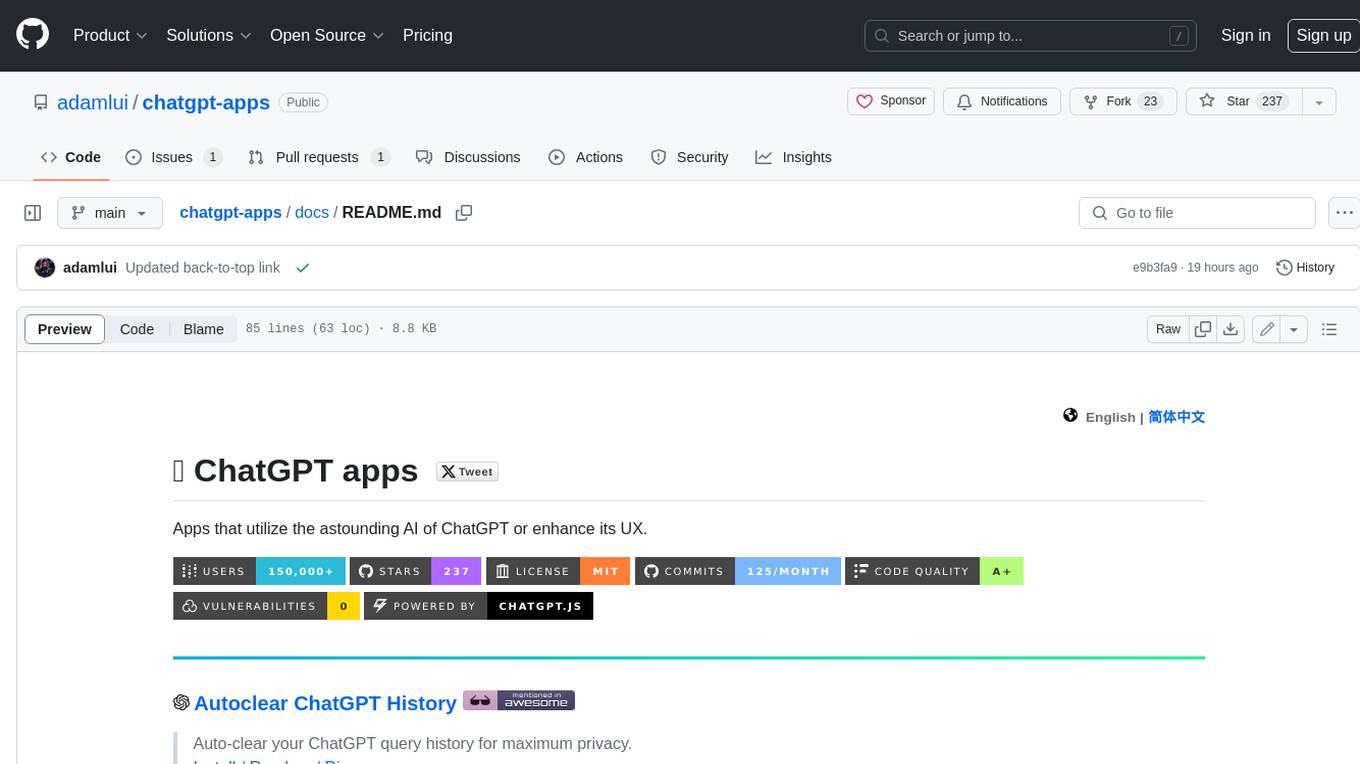
chatgpt-apps
This repository contains a collection of apps that utilize the astounding AI of ChatGPT or enhance its UX. These apps range from simple scripts to full-fledged extensions, each designed to make your ChatGPT experience more efficient, enjoyable, or private.
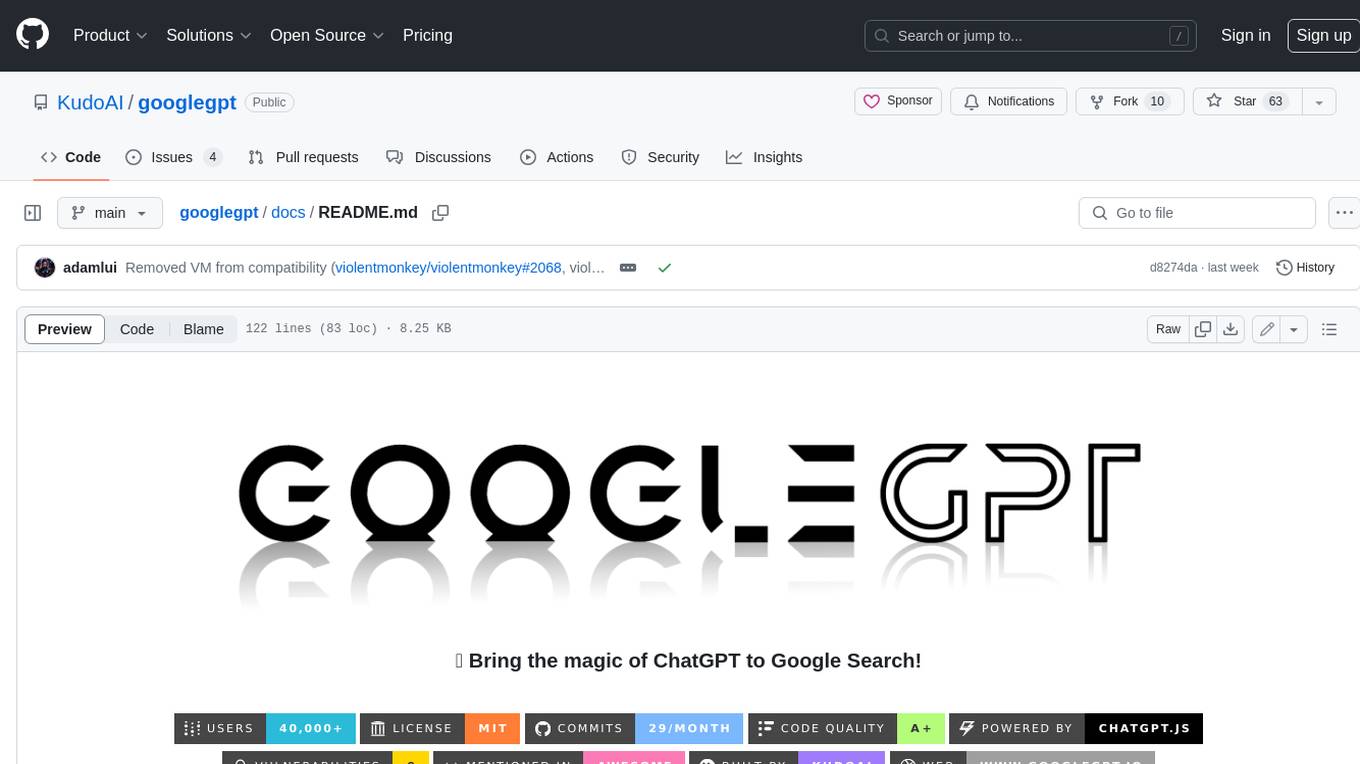
googlegpt
GoogleGPT is a browser extension that brings the power of ChatGPT to Google Search. With GoogleGPT, you can ask ChatGPT questions and get answers directly in your search results. You can also use GoogleGPT to generate text, translate languages, and more. GoogleGPT is compatible with all major browsers, including Chrome, Firefox, Edge, and Safari.
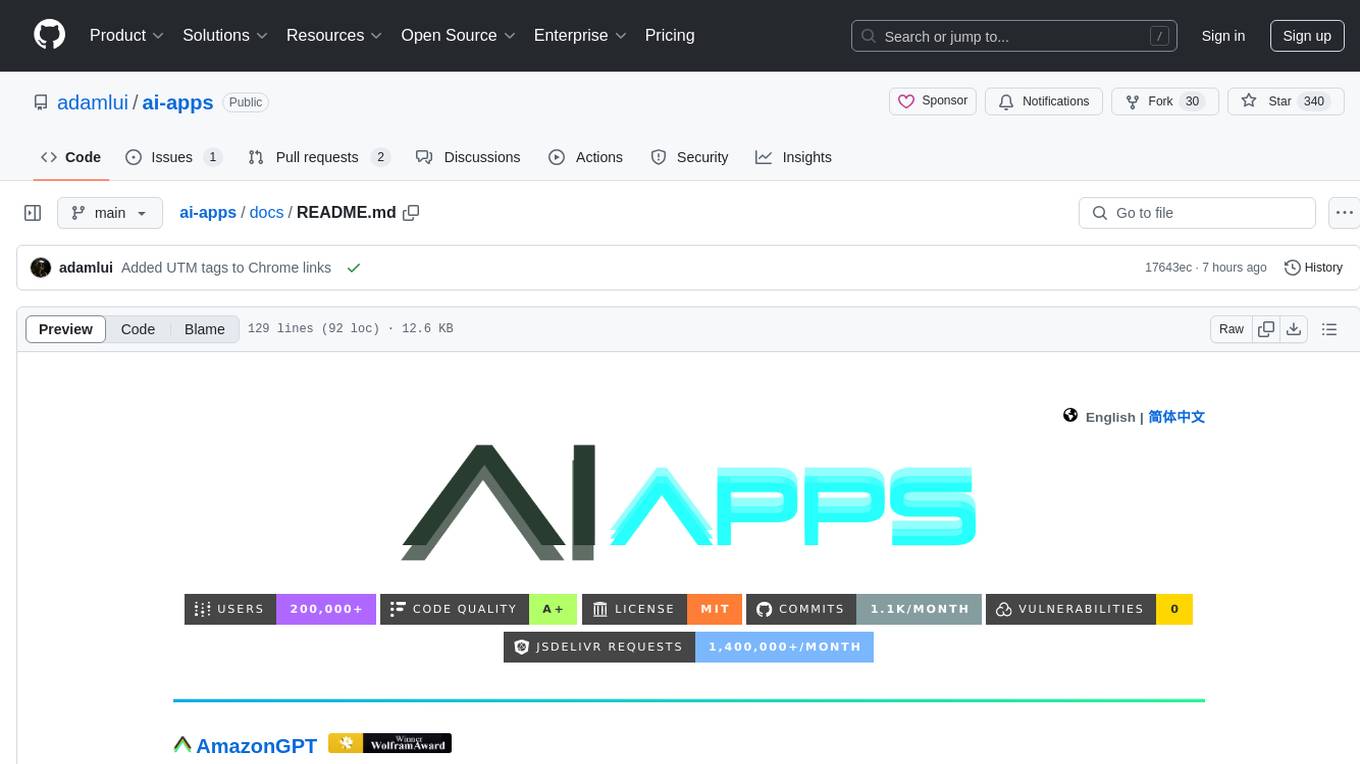
ai-apps
ai-apps is a collection of browser extensions that enhance various AI-powered services like Amazon shopping, Brave Search, ChatGPT, DuckDuckGo, and Google Search. These extensions provide functionalities such as adding AI answers to search engines, auto-clearing ChatGPT query history, auto-playing ChatGPT responses, keeping ChatGPT sessions fresh, and more. The repository offers tools to improve user experience and interaction with AI technologies across different platforms and services.
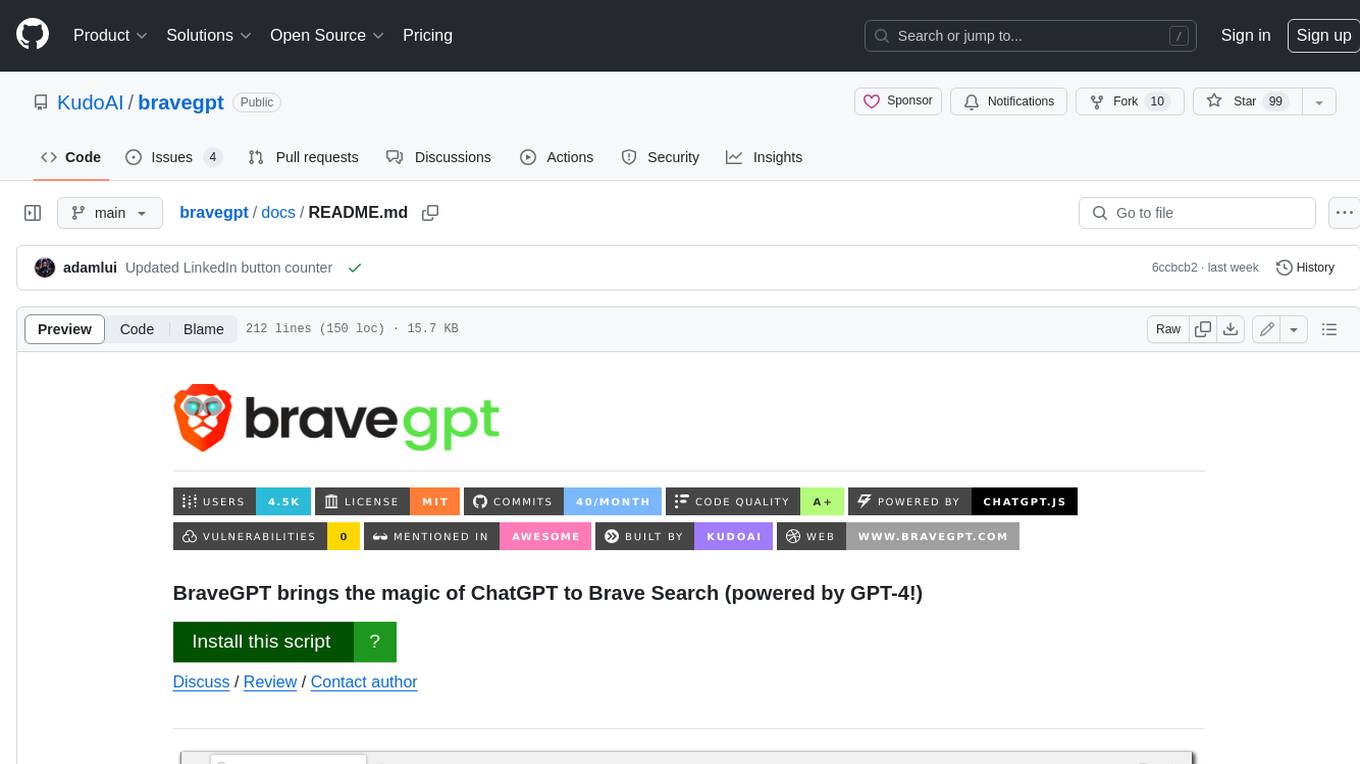
bravegpt
BraveGPT is a userscript that brings the power of ChatGPT to Brave Search. It allows users to engage with a conversational AI assistant directly within their search results, providing instant and personalized responses to their queries. BraveGPT is powered by GPT-4, the latest and most advanced language model from OpenAI, ensuring accurate and comprehensive answers. With BraveGPT, users can ask questions, get summaries, generate creative content, and more, all without leaving the Brave Search interface. The tool is easy to install and use, making it accessible to users of all levels. BraveGPT is a valuable addition to the Brave Search experience, enhancing its capabilities and providing users with a more efficient and informative search experience.
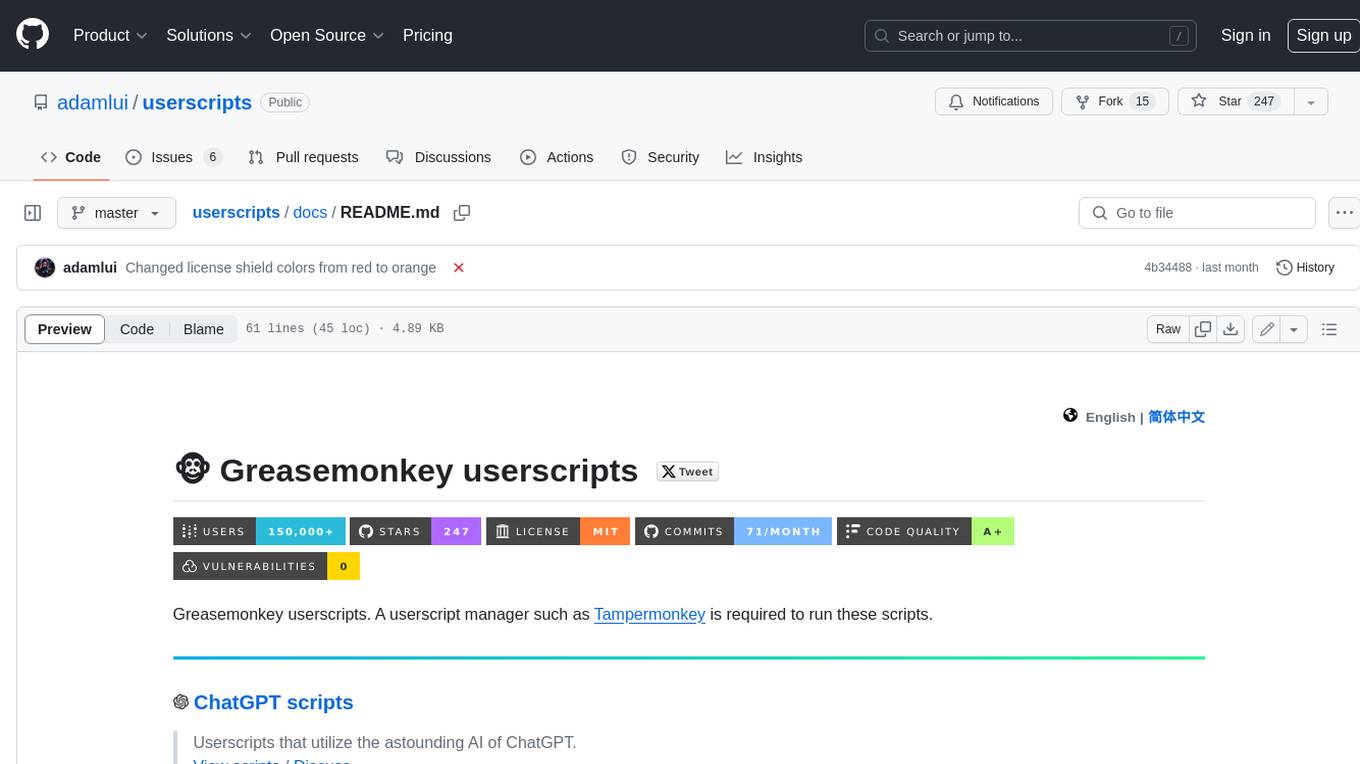
userscripts
Greasemonkey userscripts. A userscript manager such as Tampermonkey is required to run these scripts.
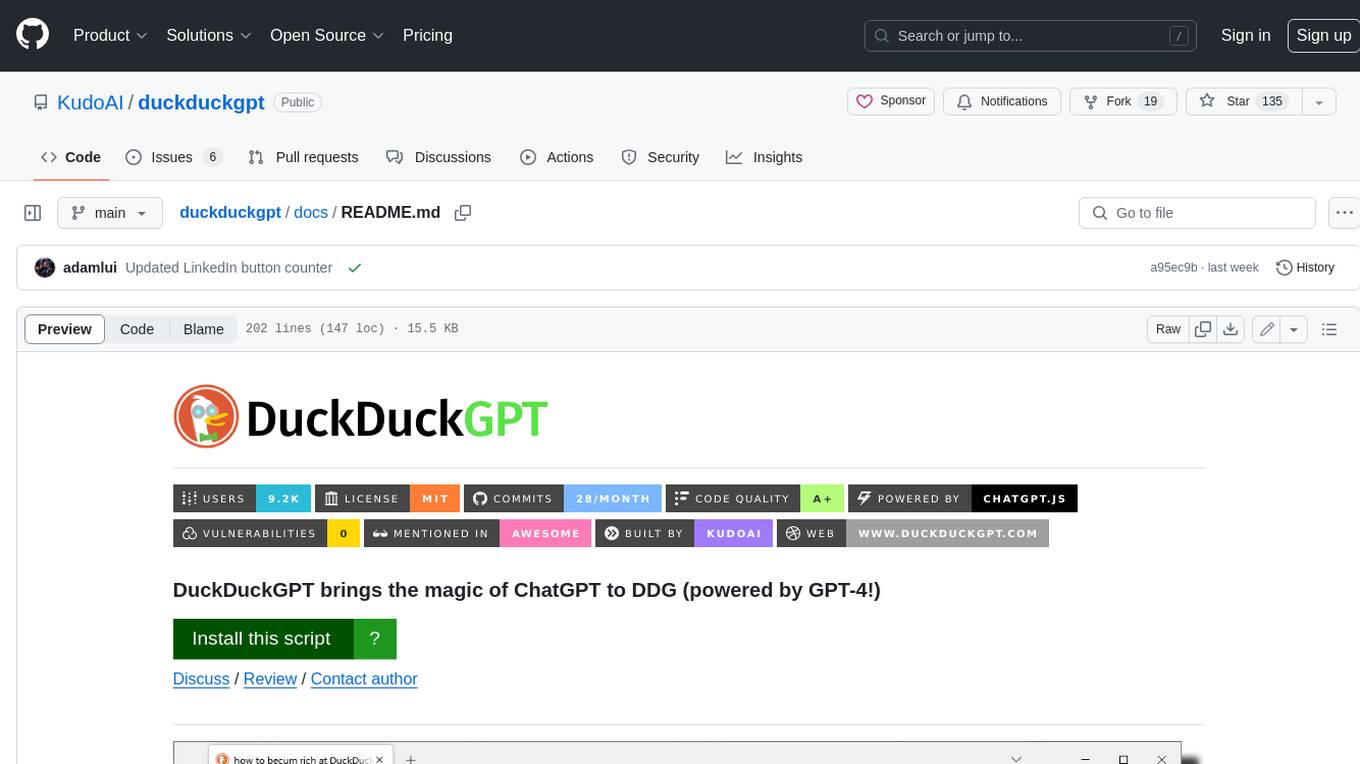
duckduckgpt
DuckDuckGPT brings the magic of ChatGPT to DDG (powered by GPT-4!). DuckDuckGPT is a browser extension that allows you to use ChatGPT within DuckDuckGo. This means you can ask ChatGPT questions, get help with tasks, and generate creative content, all without leaving DuckDuckGo. DuckDuckGPT is easy to use. Once you have installed the extension, simply type your question into the DuckDuckGo search bar and hit enter. ChatGPT will then generate a response that will appear below the search results. DuckDuckGPT is a powerful tool that can help you with a wide variety of tasks. Here are just a few examples of what you can use it for: * Get help with research * Write essays and other creative content * Translate languages * Get coding help * Answer trivia questions * And much more! DuckDuckGPT is still in development, but it is already a very powerful tool. As GPT-4 continues to improve, DuckDuckGPT will only get better. So if you are looking for a way to make your DuckDuckGo searches more productive, be sure to give DuckDuckGPT a try.
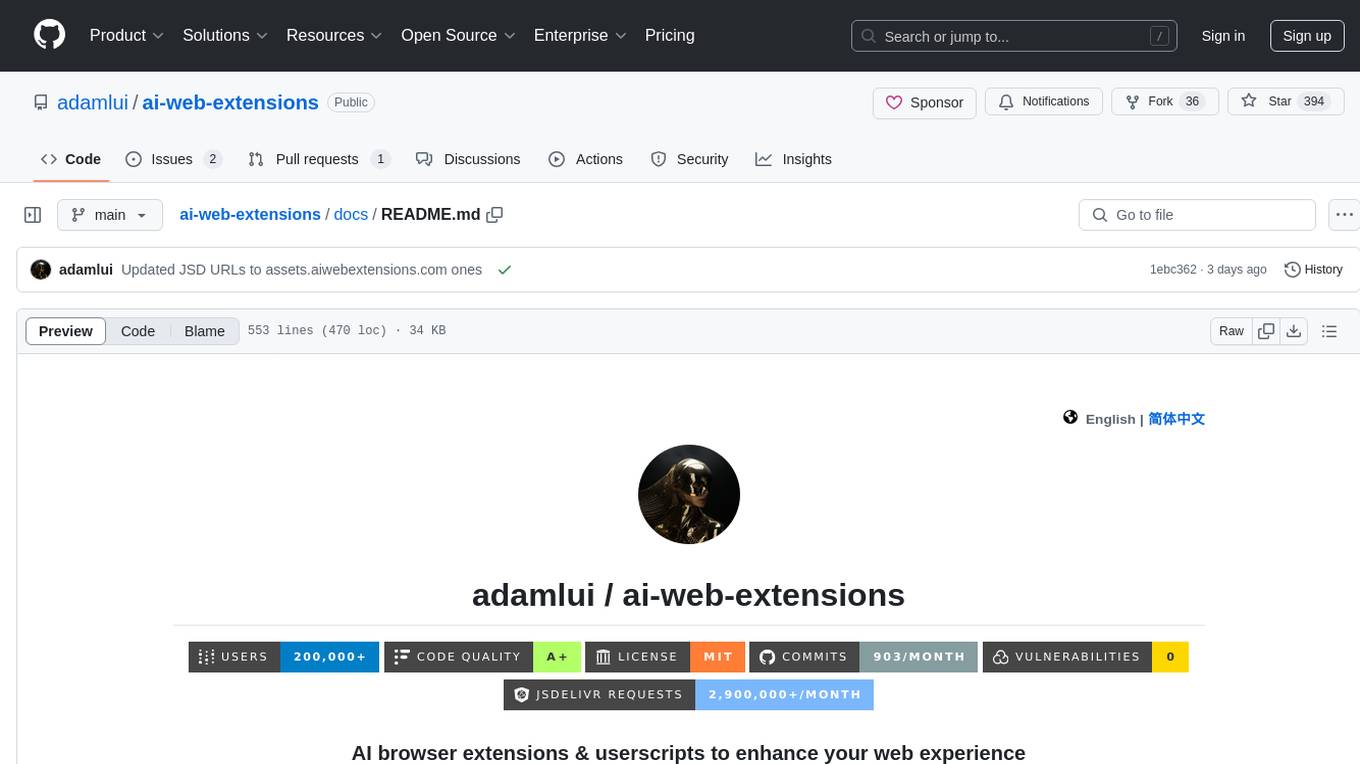
ai-web-extensions
AI Web Extensions is a collection of browser extensions and userscripts designed to enhance the web browsing experience by adding AI capabilities to various platforms such as Amazon, Brave, ChatGPT, DuckDuckGo, Google Search, Perplexity AI, Phind AI, and You.com. These extensions enable users to interact with AI-powered features like auto-clearing ChatGPT history, auto-playing ChatGPT responses, generating endless answers from ChatGPT, adding widescreen and fullscreen modes to chat platforms, and more. The extensions are compatible with popular browsers like Chrome, Firefox, and Edge, and can be installed using tools like Greasemonkey and Violentmonkey.
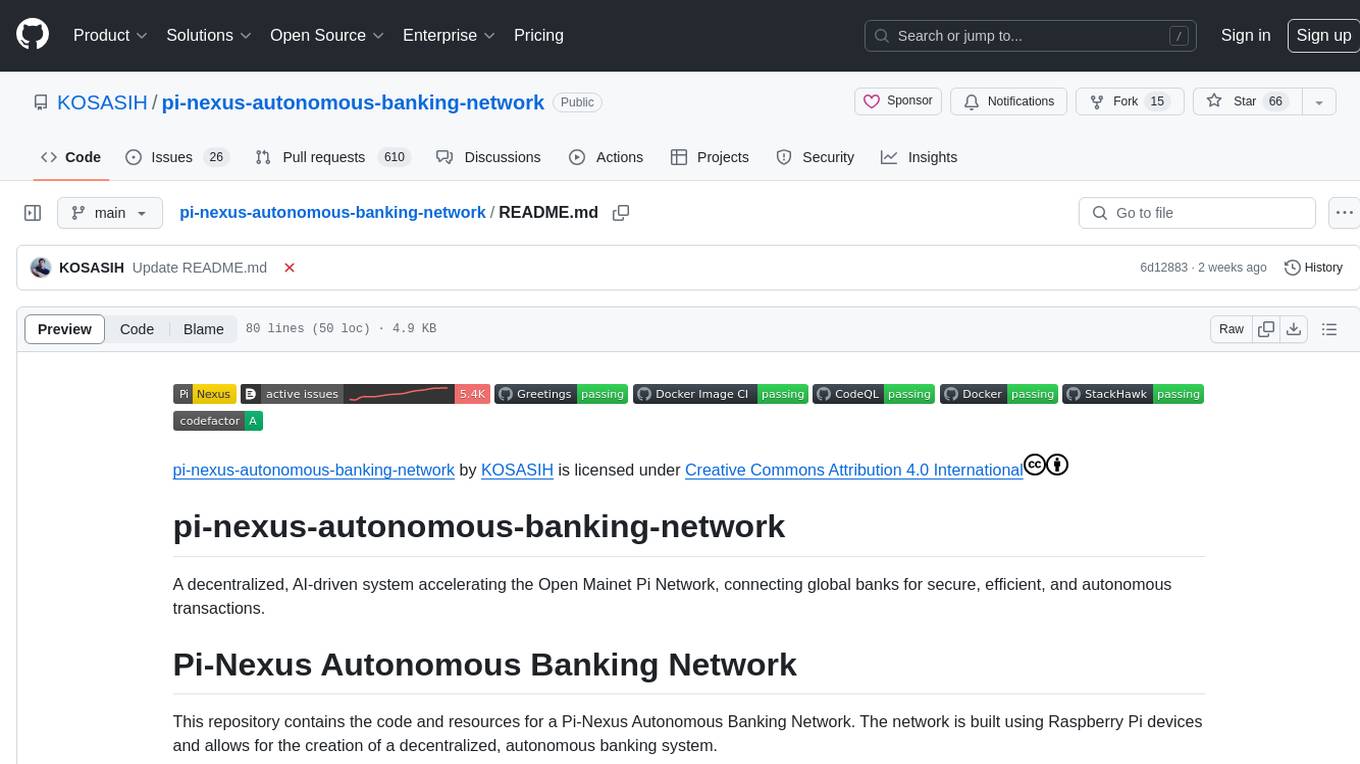
pi-nexus-autonomous-banking-network
A decentralized, AI-driven system accelerating the Open Mainet Pi Network, connecting global banks for secure, efficient, and autonomous transactions. The Pi-Nexus Autonomous Banking Network is built using Raspberry Pi devices and allows for the creation of a decentralized, autonomous banking system.
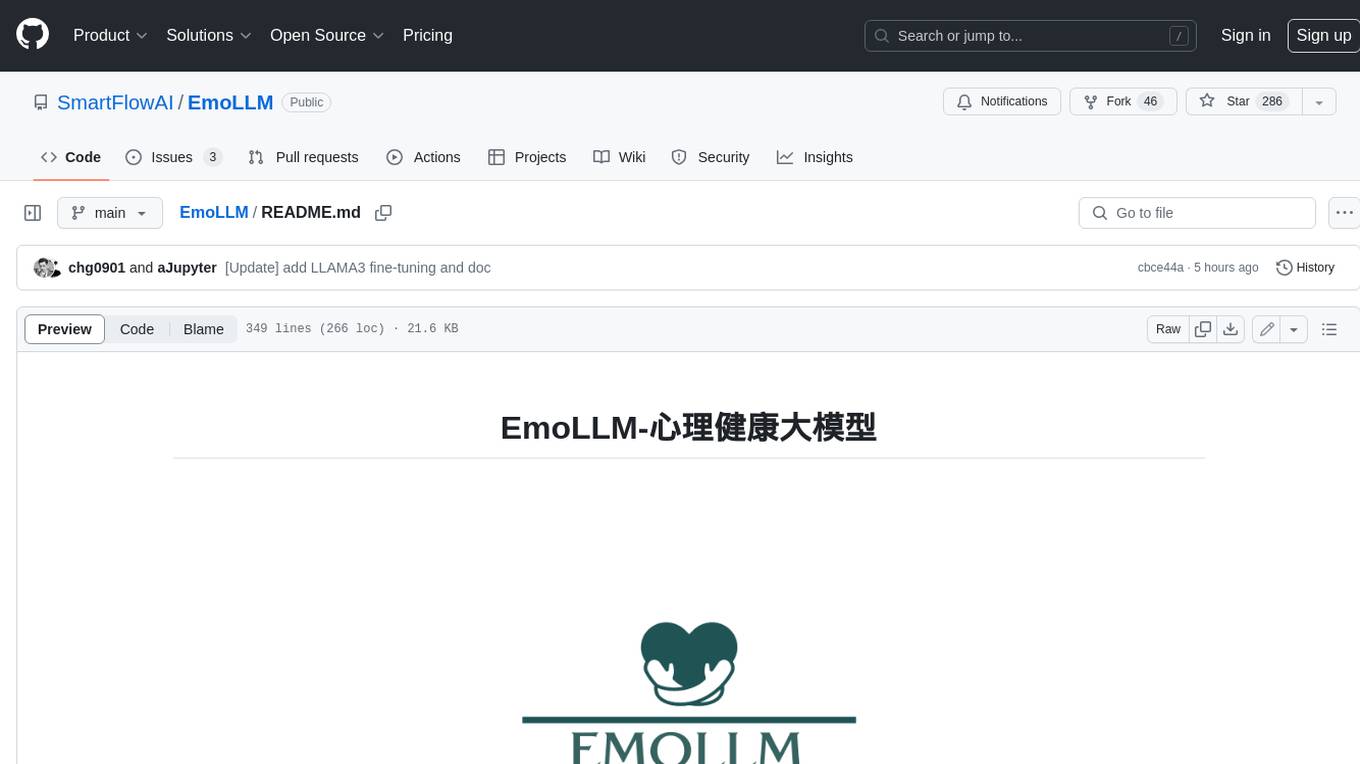
EmoLLM
EmoLLM is a series of large-scale psychological health counseling models that can support **understanding-supporting-helping users** in the psychological health counseling chain, which is fine-tuned from `LLM` instructions. Welcome everyone to star~⭐⭐. The currently open source `LLM` fine-tuning configurations are as follows:
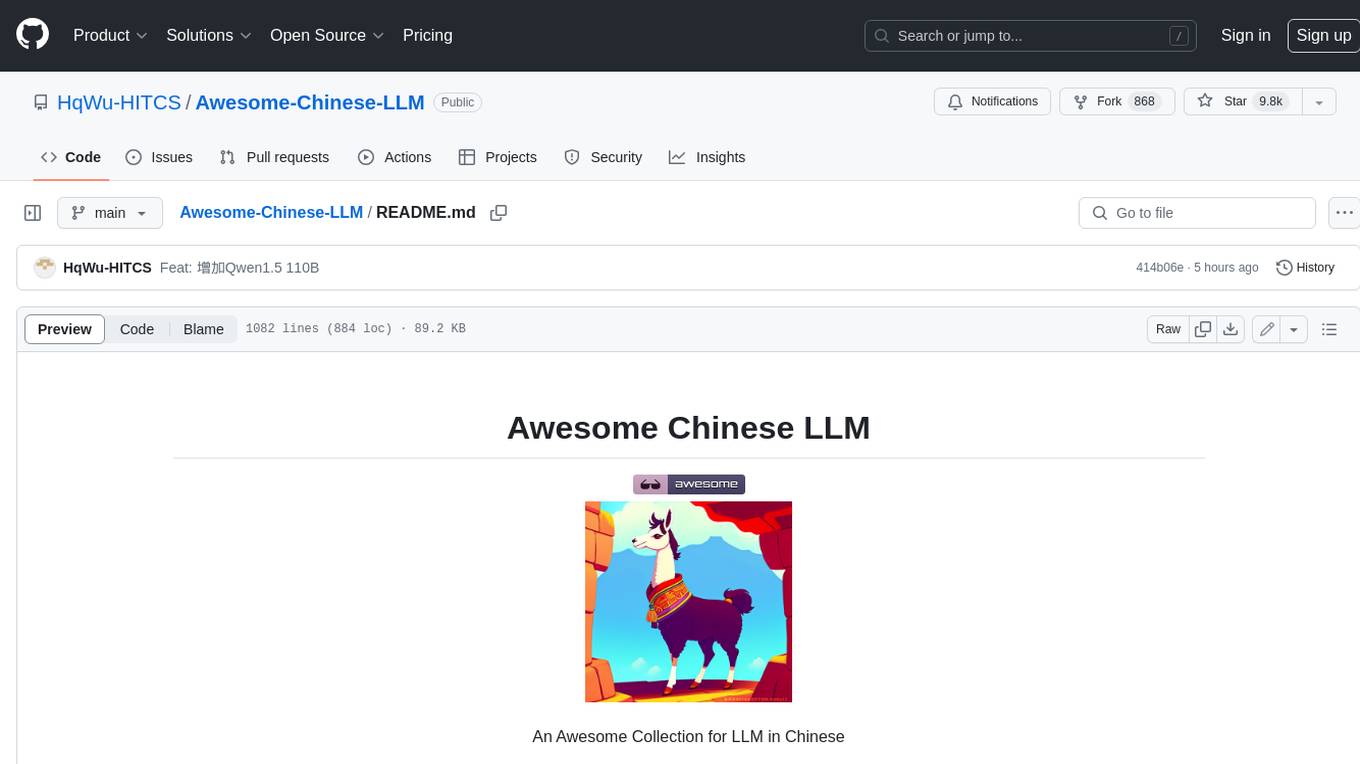
Awesome-Chinese-LLM
Analyze the following text from a github repository (name and readme text at end) . Then, generate a JSON object with the following keys and provide the corresponding information for each key, ,'for_jobs' (List 5 jobs suitable for this tool,in lowercase letters), 'ai_keywords' (keywords of the tool,in lowercase letters), 'for_tasks' (list of 5 specific tasks user can use this tool to do,in less than 3 words,Verb + noun form,in daily spoken language,in lowercase letters).Answer in english languagesname:Awesome-Chinese-LLM readme:# Awesome Chinese LLM   An Awesome Collection for LLM in Chinese 收集和梳理中文LLM相关    自ChatGPT为代表的大语言模型(Large Language Model, LLM)出现以后,由于其惊人的类通用人工智能(AGI)的能力,掀起了新一轮自然语言处理领域的研究和应用的浪潮。尤其是以ChatGLM、LLaMA等平民玩家都能跑起来的较小规模的LLM开源之后,业界涌现了非常多基于LLM的二次微调或应用的案例。本项目旨在收集和梳理中文LLM相关的开源模型、应用、数据集及教程等资料,目前收录的资源已达100+个! 如果本项目能给您带来一点点帮助,麻烦点个⭐️吧~ 同时也欢迎大家贡献本项目未收录的开源模型、应用、数据集等。提供新的仓库信息请发起PR,并按照本项目的格式提供仓库链接、star数,简介等相关信息,感谢~
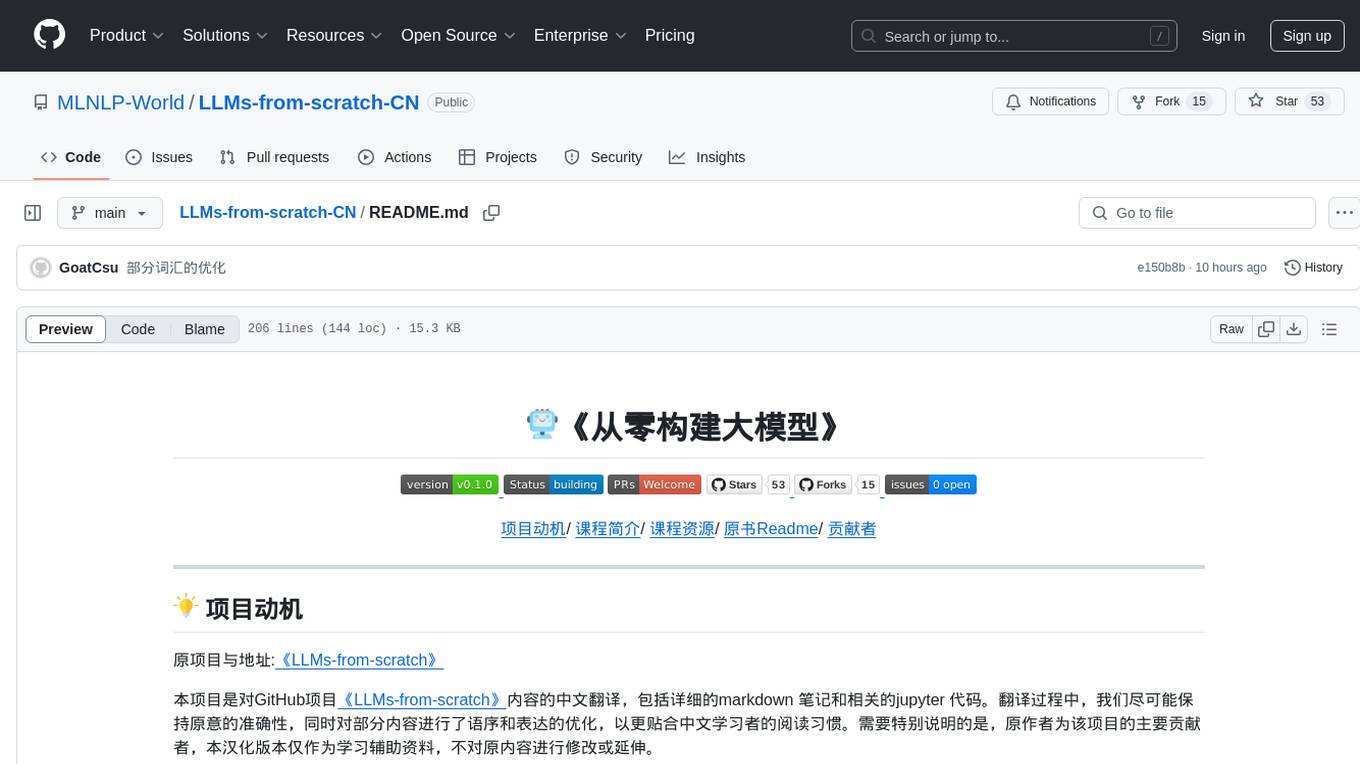
LLMs-from-scratch-CN
This repository is a Chinese translation of the GitHub project 'LLMs-from-scratch', including detailed markdown notes and related Jupyter code. The translation process aims to maintain the accuracy of the original content while optimizing the language and expression to better suit Chinese learners' reading habits. The repository features detailed Chinese annotations for all Jupyter code, aiding users in practical implementation. It also provides various supplementary materials to expand knowledge. The project focuses on building Large Language Models (LLMs) from scratch, covering fundamental constructions like Transformer architecture, sequence modeling, and delving into deep learning models such as GPT and BERT. Each part of the project includes detailed code implementations and learning resources to help users construct LLMs from scratch and master their core technologies.
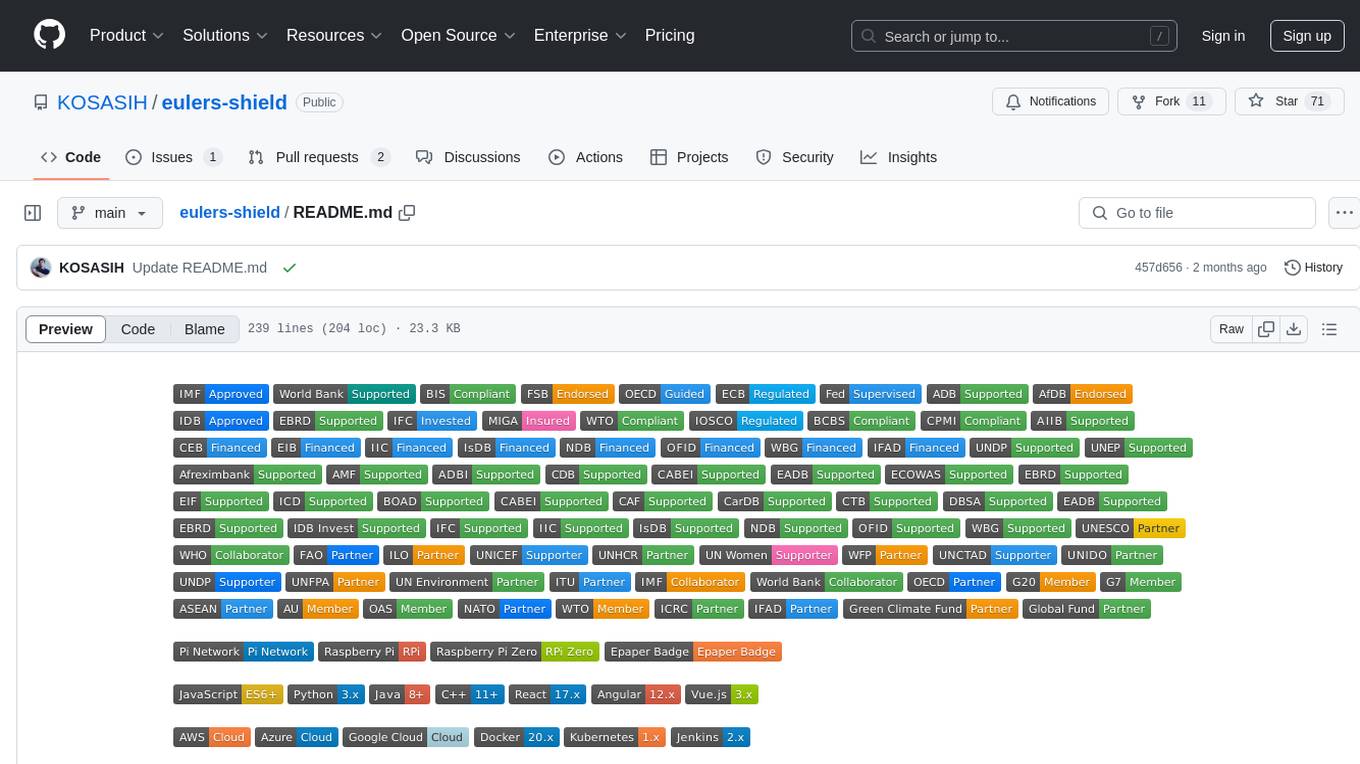
eulers-shield
Euler's Shield is a decentralized, AI-powered financial system designed to stabilize the value of Pi Coin at $314.159. It combines blockchain, machine learning, and cybersecurity to ensure the security, scalability, and decentralization of the Pi Coin ecosystem.
lobe-icons
Lobe Icons is a collection of popular AI / LLM Model Brand SVG logos and icons. It features lightweight and scalable icons designed with highly optimized scalable vector graphics (SVG) for optimal performance. The collection is tree-shakable, allowing users to import only the icons they need to reduce the overall bundle size of their projects. Lobe Icons has an active community of designers and developers who can contribute and seek support on platforms like GitHub and Discord. The repository supports a wide range of brands across different models, providers, and applications, with more brands continuously being added through contributions. Users can easily install Lobe UI with the provided commands and integrate it with NextJS for server-side rendering. Local development can be done using Github Codespaces or by cloning the repository. Contributions are welcome, and users can contribute code by checking out the GitHub Issues. The project is MIT licensed and maintained by LobeHub.
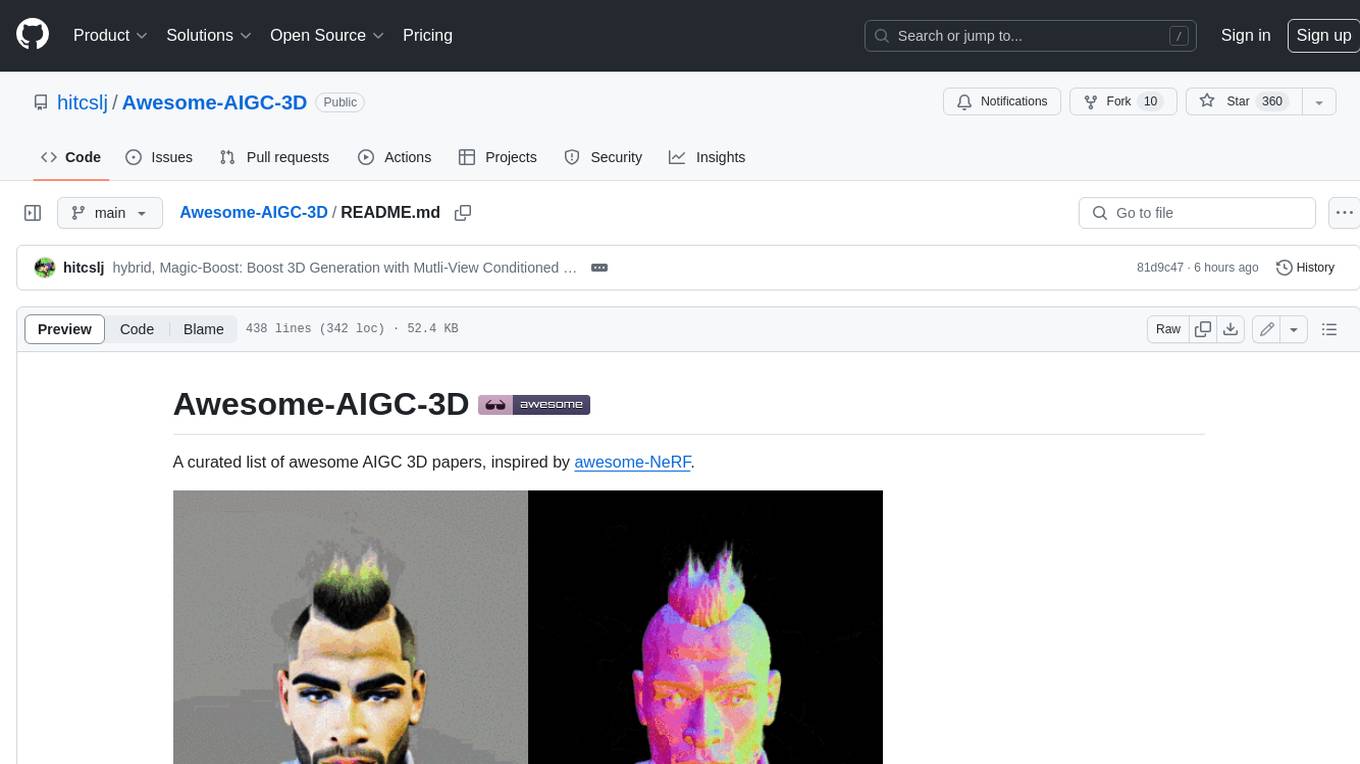
Awesome-AIGC-3D
Awesome-AIGC-3D is a curated list of awesome AIGC 3D papers, inspired by awesome-NeRF. It aims to provide a comprehensive overview of the state-of-the-art in AIGC 3D, including papers on text-to-3D generation, 3D scene generation, human avatar generation, and dynamic 3D generation. The repository also includes a list of benchmarks and datasets, talks, companies, and implementations related to AIGC 3D. The description is less than 400 words and provides a concise overview of the repository's content and purpose.
For similar tasks

how-to-optim-algorithm-in-cuda
This repository documents how to optimize common algorithms based on CUDA. It includes subdirectories with code implementations for specific optimizations. The optimizations cover topics such as compiling PyTorch from source, NVIDIA's reduce optimization, OneFlow's elementwise template, fast atomic add for half data types, upsample nearest2d optimization in OneFlow, optimized indexing in PyTorch, OneFlow's softmax kernel, linear attention optimization, and more. The repository also includes learning resources related to deep learning frameworks, compilers, and optimization techniques.
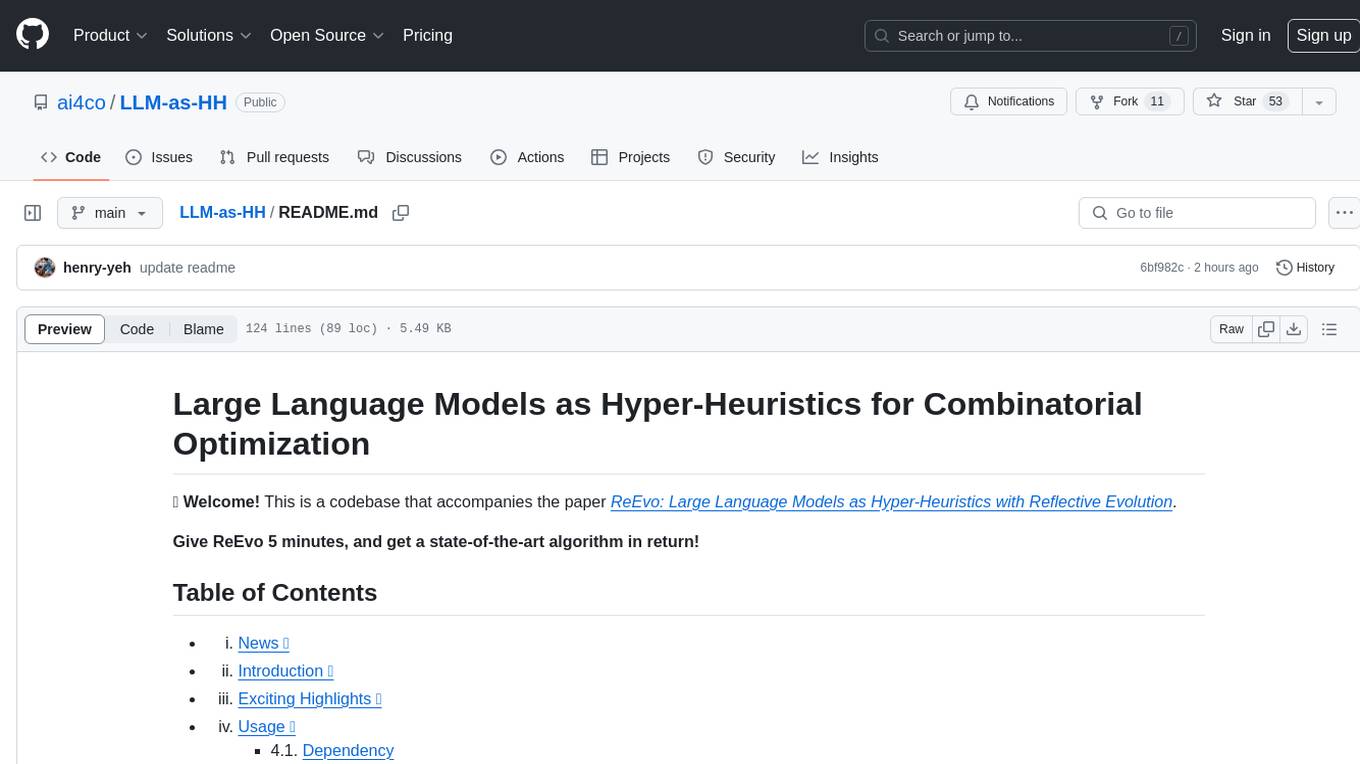
LLM-as-HH
LLM-as-HH is a codebase that accompanies the paper ReEvo: Large Language Models as Hyper-Heuristics with Reflective Evolution. It introduces Language Hyper-Heuristics (LHHs) that leverage LLMs for heuristic generation with minimal manual intervention and open-ended heuristic spaces. Reflective Evolution (ReEvo) is presented as a searching framework that emulates the reflective design approach of human experts while surpassing human capabilities with scalable LLM inference, Internet-scale domain knowledge, and powerful evolutionary search. The tool can improve various algorithms on problems like Traveling Salesman Problem, Capacitated Vehicle Routing Problem, Orienteering Problem, Multiple Knapsack Problems, Bin Packing Problem, and Decap Placement Problem in both black-box and white-box settings.
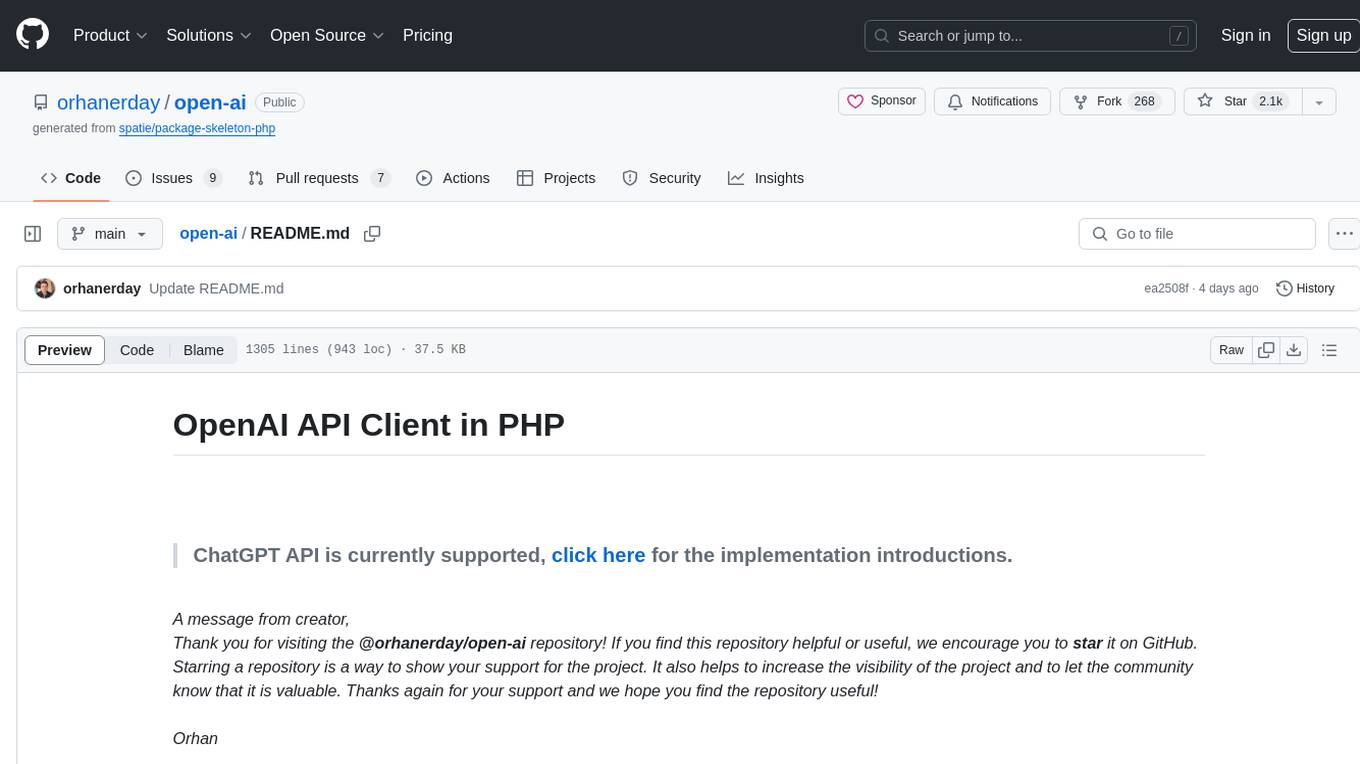
open-ai
Open AI is a powerful tool for artificial intelligence research and development. It provides a wide range of machine learning models and algorithms, making it easier for developers to create innovative AI applications. With Open AI, users can explore cutting-edge technologies such as natural language processing, computer vision, and reinforcement learning. The platform offers a user-friendly interface and comprehensive documentation to support users in building and deploying AI solutions. Whether you are a beginner or an experienced AI practitioner, Open AI offers the tools and resources you need to accelerate your AI projects and stay ahead in the rapidly evolving field of artificial intelligence.

universal
The Universal Numbers Library is a header-only C++ template library designed for universal number arithmetic, offering alternatives to native integer and floating-point for mixed-precision algorithm development and optimization. It tailors arithmetic types to the application's precision and dynamic range, enabling improved application performance and energy efficiency. The library provides fast implementations of special IEEE-754 formats like quarter precision, half-precision, and quad precision, as well as vendor-specific extensions. It supports static and elastic integers, decimals, fixed-points, rationals, linear floats, tapered floats, logarithmic, interval, and adaptive-precision integers, rationals, and floats. The library is suitable for AI, DSP, HPC, and HFT algorithms.
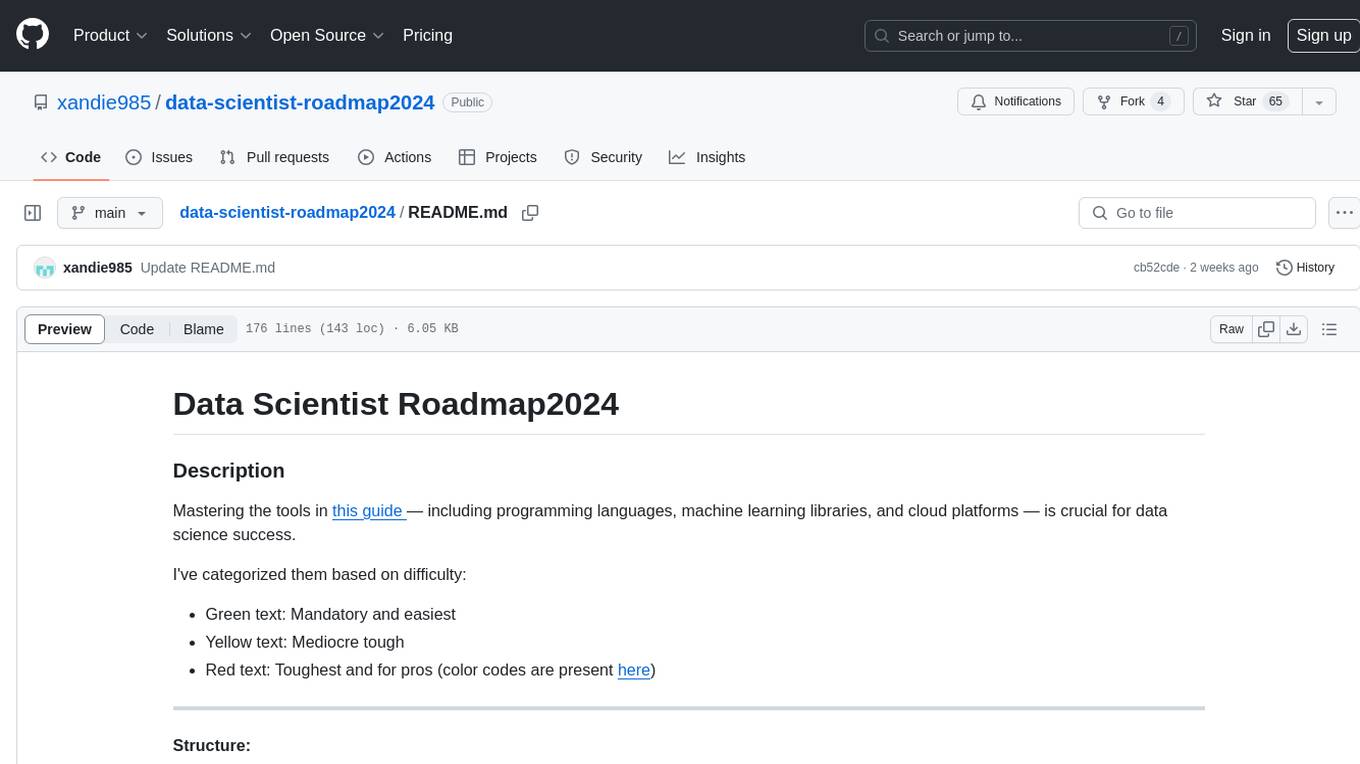
data-scientist-roadmap2024
The Data Scientist Roadmap2024 provides a comprehensive guide to mastering essential tools for data science success. It includes programming languages, machine learning libraries, cloud platforms, and concepts categorized by difficulty. The roadmap covers a wide range of topics from programming languages to machine learning techniques, data visualization tools, and DevOps/MLOps tools. It also includes web development frameworks and specific concepts like supervised and unsupervised learning, NLP, deep learning, reinforcement learning, and statistics. Additionally, it delves into DevOps tools like Airflow and MLFlow, data visualization tools like Tableau and Matplotlib, and other topics such as ETL processes, optimization algorithms, and financial modeling.
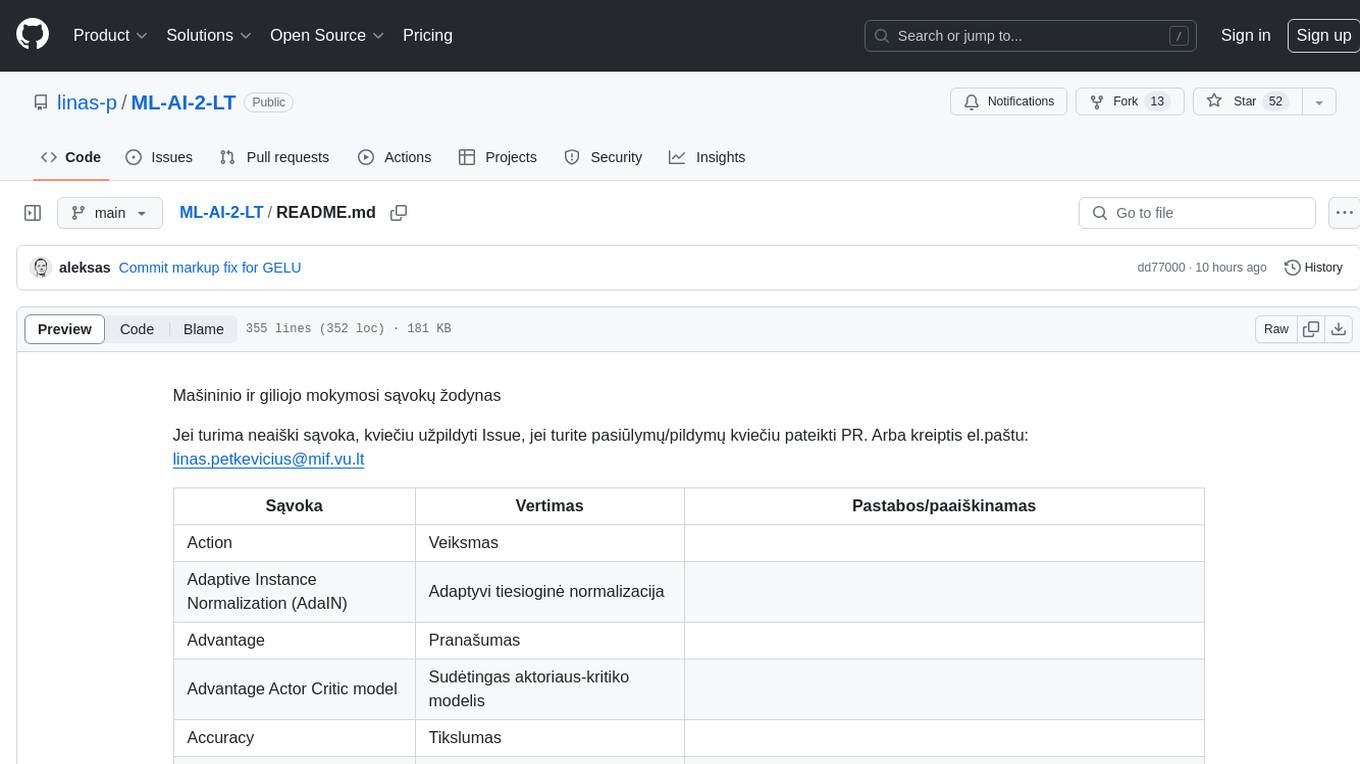
ML-AI-2-LT
ML-AI-2-LT is a repository that serves as a glossary for machine learning and deep learning concepts. It contains translations and explanations of various terms related to artificial intelligence, including definitions and notes. Users can contribute by filling issues for unclear concepts or by submitting pull requests with suggestions or additions. The repository aims to provide a comprehensive resource for understanding key terminology in the field of AI and machine learning.
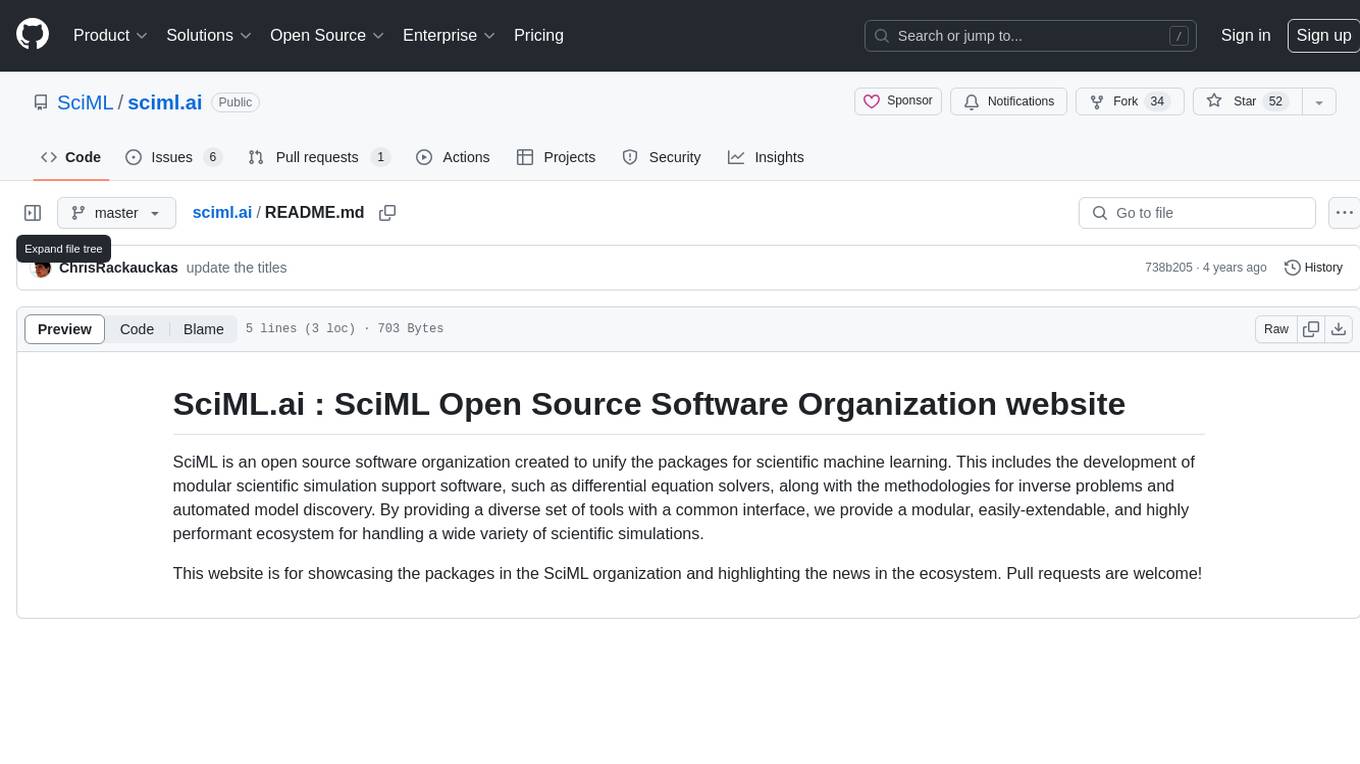
sciml.ai
SciML.ai is an open source software organization dedicated to unifying packages for scientific machine learning. It focuses on developing modular scientific simulation support software, including differential equation solvers, inverse problems methodologies, and automated model discovery. The organization aims to provide a diverse set of tools with a common interface, creating a modular, easily-extendable, and highly performant ecosystem for scientific simulations. The website serves as a platform to showcase SciML organization's packages and share news within the ecosystem. Pull requests are encouraged for contributions.
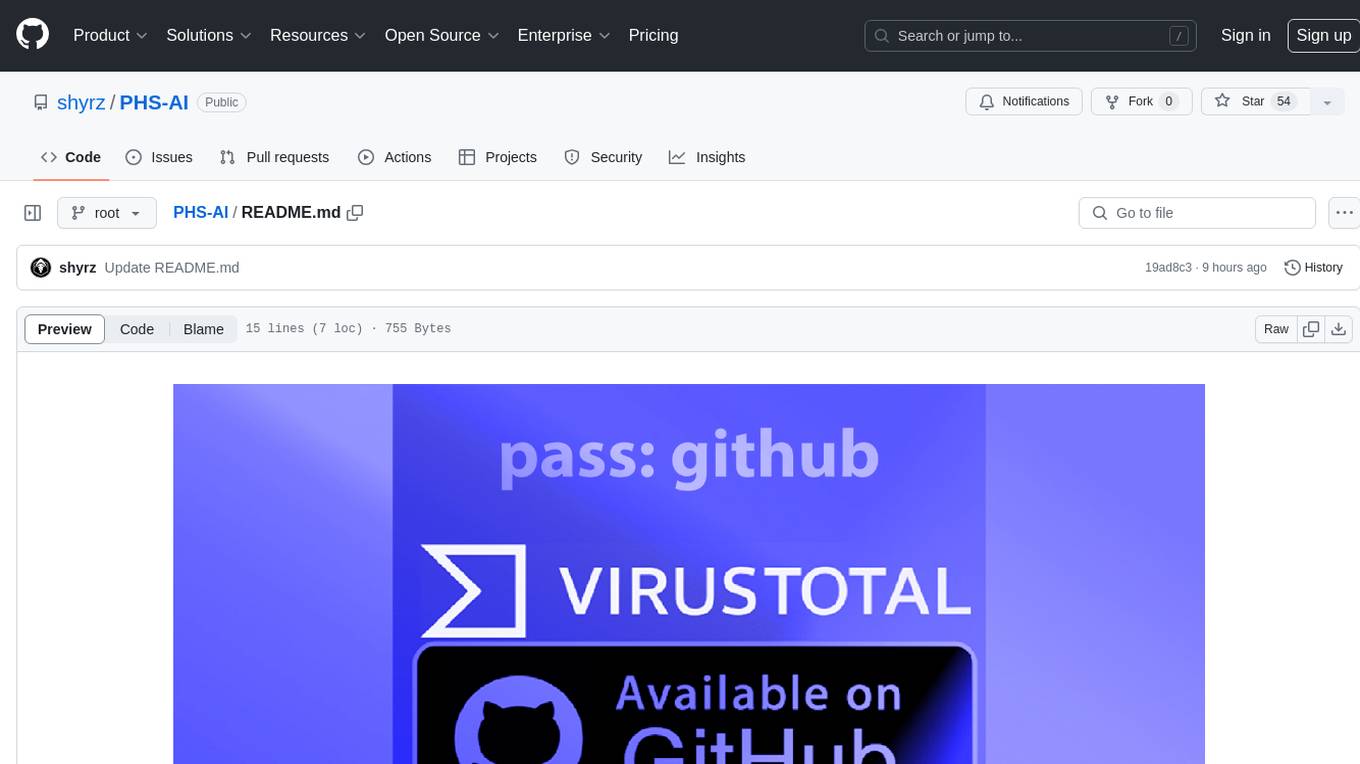
PHS-AI
PHS-AI is a project that provides functionality as is, without any warranties or commitments. Users are advised to exercise caution when using the code and conduct thorough testing before deploying in a production environment. The author assumes no responsibility for any losses or damages incurred through the use of this code. Feedback and contributions to improve the project are always welcome.
For similar jobs
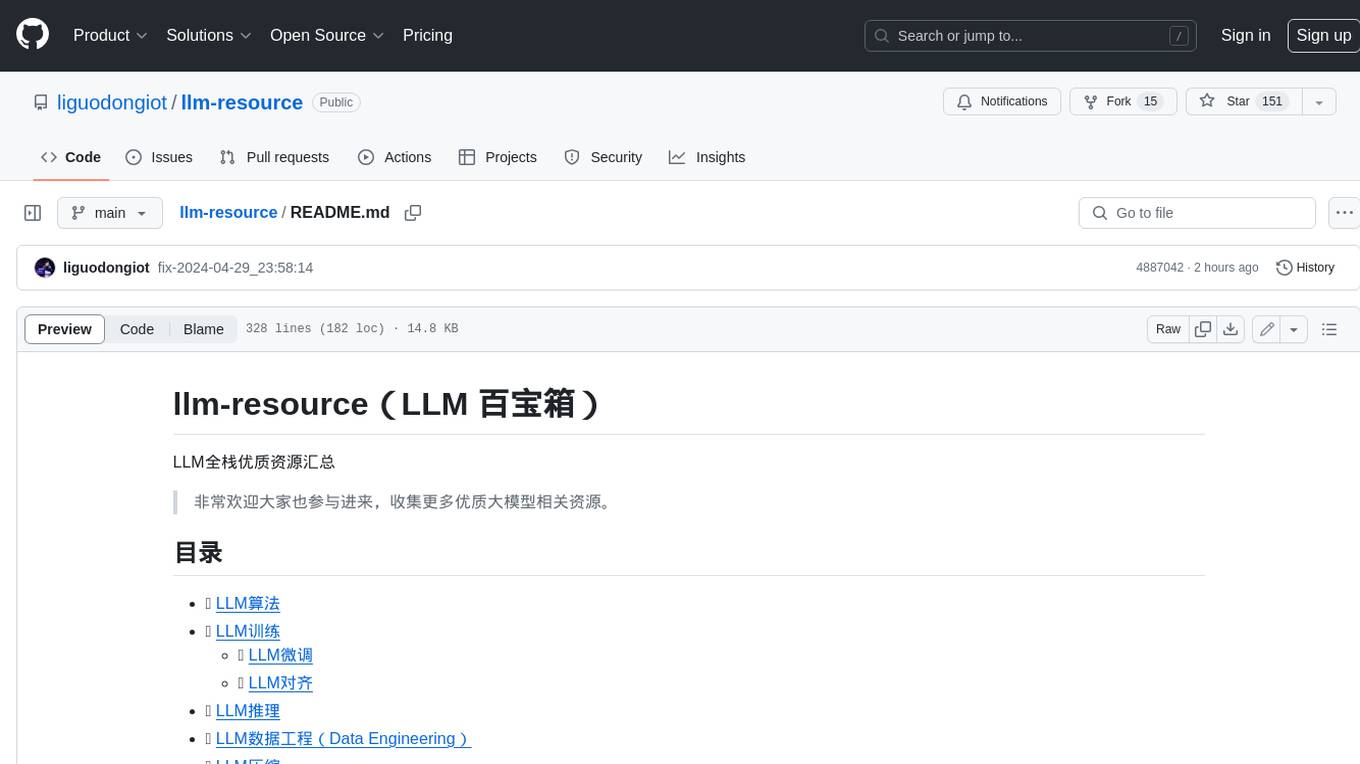
llm-resource
llm-resource is a comprehensive collection of high-quality resources for Large Language Models (LLM). It covers various aspects of LLM including algorithms, training, fine-tuning, alignment, inference, data engineering, compression, evaluation, prompt engineering, AI frameworks, AI basics, AI infrastructure, AI compilers, LLM application development, LLM operations, AI systems, and practical implementations. The repository aims to gather and share valuable resources related to LLM for the community to benefit from.
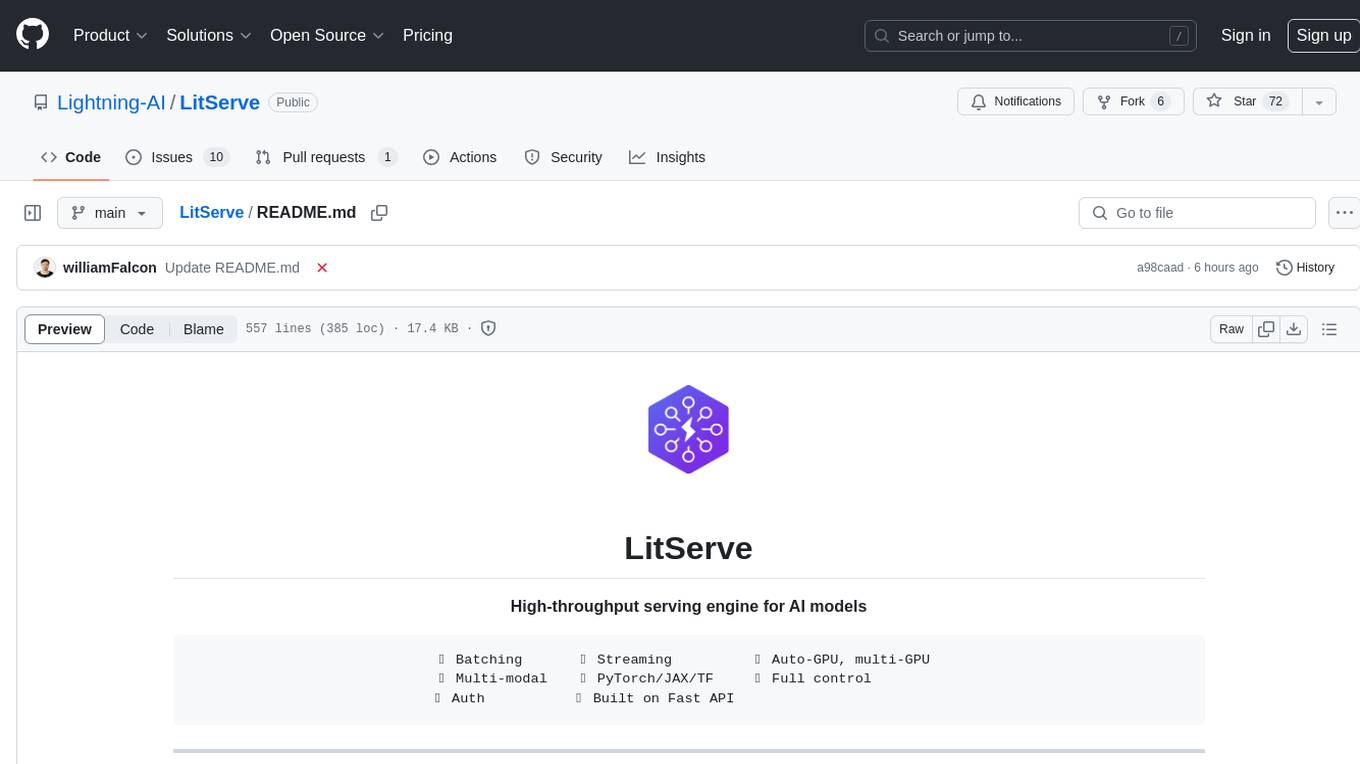
LitServe
LitServe is a high-throughput serving engine designed for deploying AI models at scale. It generates an API endpoint for models, handles batching, streaming, and autoscaling across CPU/GPUs. LitServe is built for enterprise scale with a focus on minimal, hackable code-base without bloat. It supports various model types like LLMs, vision, time-series, and works with frameworks like PyTorch, JAX, Tensorflow, and more. The tool allows users to focus on model performance rather than serving boilerplate, providing full control and flexibility.

how-to-optim-algorithm-in-cuda
This repository documents how to optimize common algorithms based on CUDA. It includes subdirectories with code implementations for specific optimizations. The optimizations cover topics such as compiling PyTorch from source, NVIDIA's reduce optimization, OneFlow's elementwise template, fast atomic add for half data types, upsample nearest2d optimization in OneFlow, optimized indexing in PyTorch, OneFlow's softmax kernel, linear attention optimization, and more. The repository also includes learning resources related to deep learning frameworks, compilers, and optimization techniques.
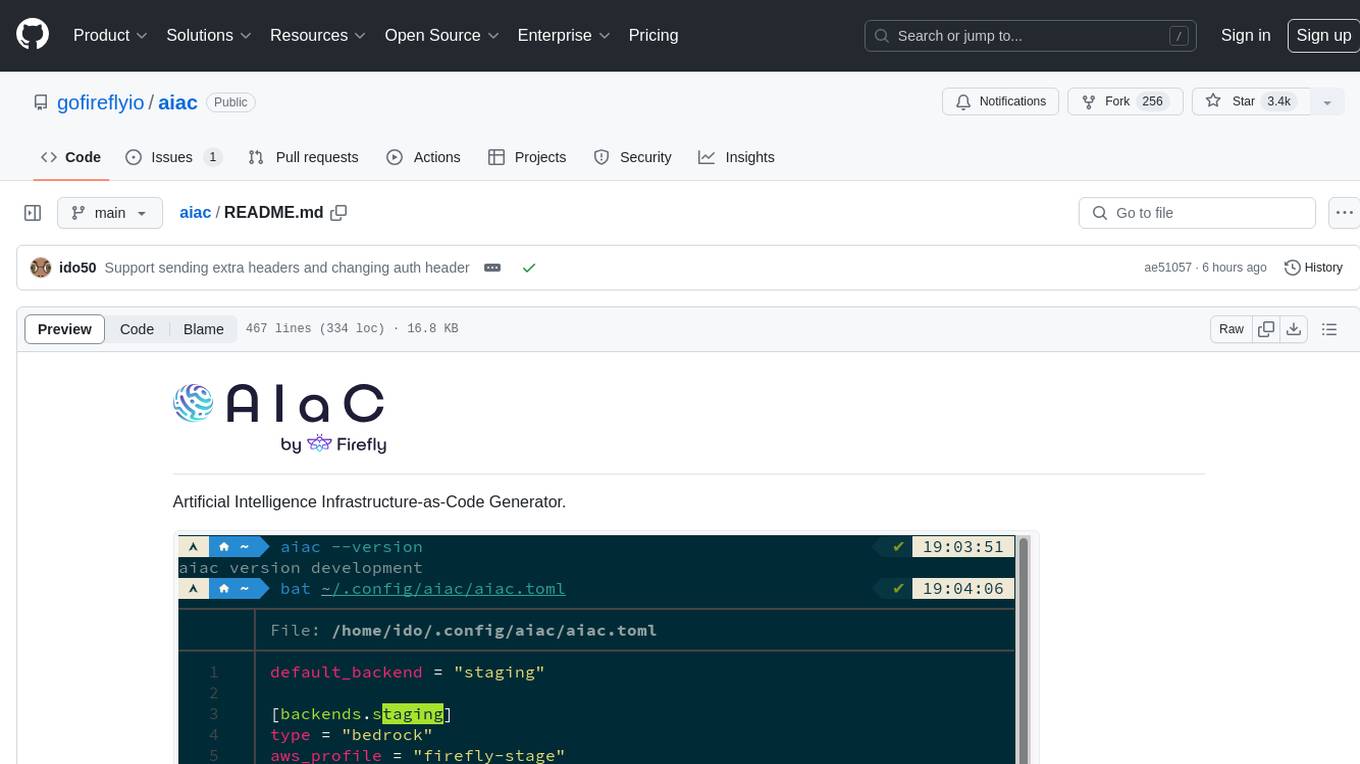
aiac
AIAC is a library and command line tool to generate Infrastructure as Code (IaC) templates, configurations, utilities, queries, and more via LLM providers such as OpenAI, Amazon Bedrock, and Ollama. Users can define multiple 'backends' targeting different LLM providers and environments using a simple configuration file. The tool allows users to ask a model to generate templates for different scenarios and composes an appropriate request to the selected provider, storing the resulting code to a file and/or printing it to standard output.
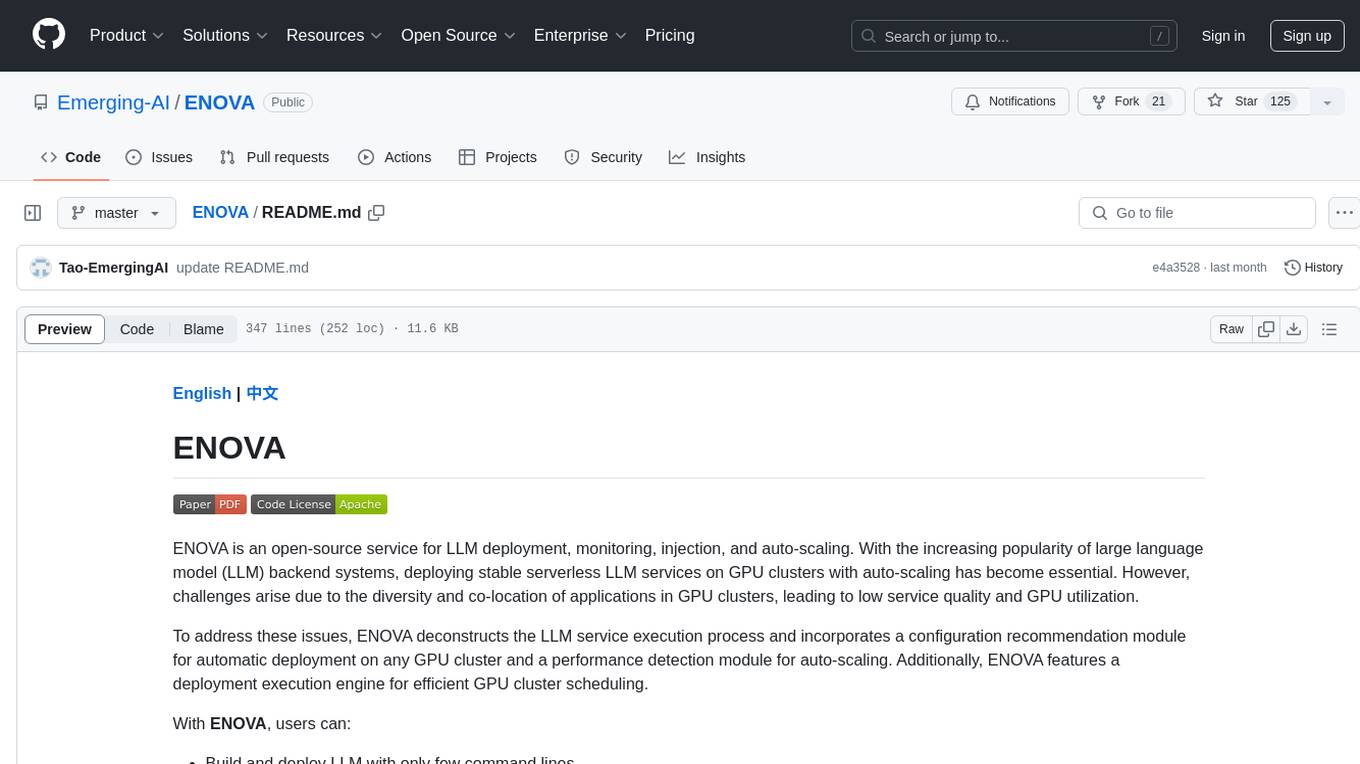
ENOVA
ENOVA is an open-source service for Large Language Model (LLM) deployment, monitoring, injection, and auto-scaling. It addresses challenges in deploying stable serverless LLM services on GPU clusters with auto-scaling by deconstructing the LLM service execution process and providing configuration recommendations and performance detection. Users can build and deploy LLM with few command lines, recommend optimal computing resources, experience LLM performance, observe operating status, achieve load balancing, and more. ENOVA ensures stable operation, cost-effectiveness, efficiency, and strong scalability of LLM services.
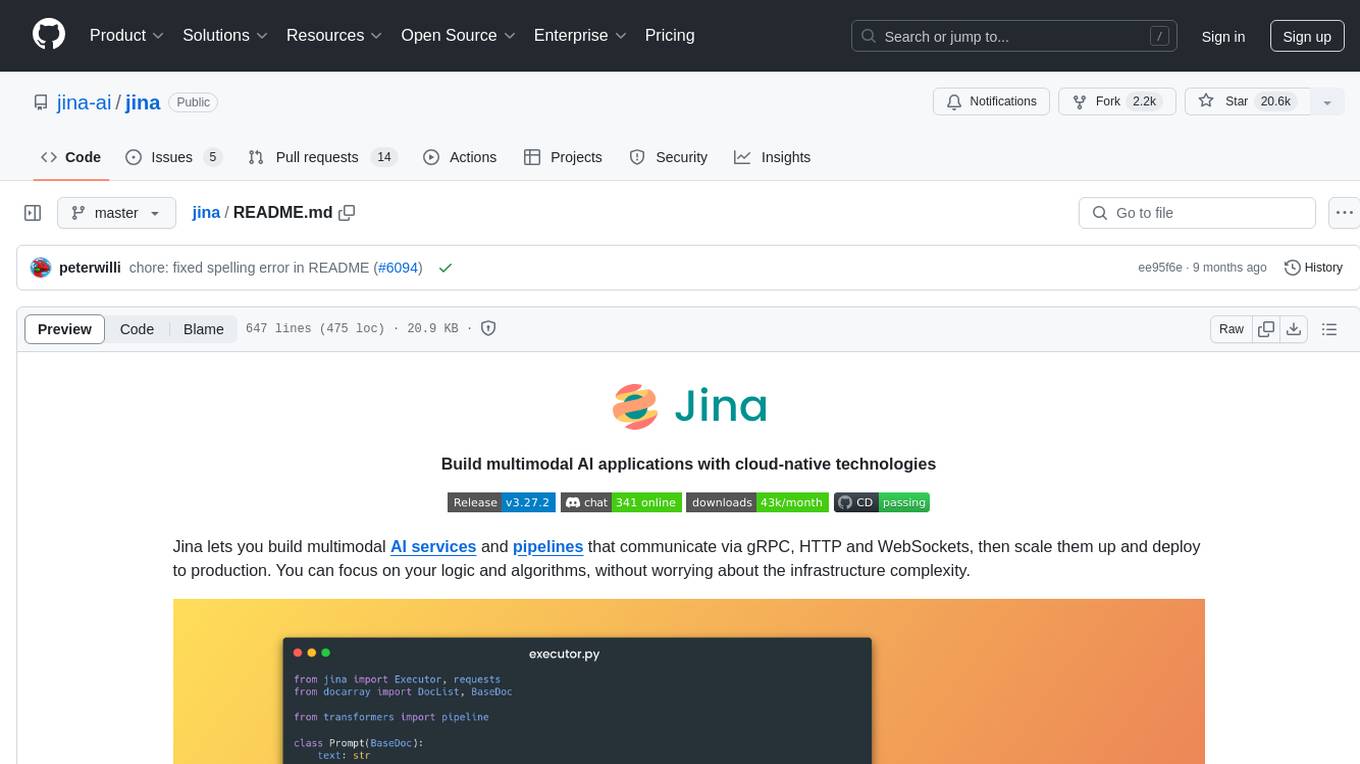
jina
Jina is a tool that allows users to build multimodal AI services and pipelines using cloud-native technologies. It provides a Pythonic experience for serving ML models and transitioning from local deployment to advanced orchestration frameworks like Docker-Compose, Kubernetes, or Jina AI Cloud. Users can build and serve models for any data type and deep learning framework, design high-performance services with easy scaling, serve LLM models while streaming their output, integrate with Docker containers via Executor Hub, and host on CPU/GPU using Jina AI Cloud. Jina also offers advanced orchestration and scaling capabilities, a smooth transition to the cloud, and easy scalability and concurrency features for applications. Users can deploy to their own cloud or system with Kubernetes and Docker Compose integration, and even deploy to JCloud for autoscaling and monitoring.
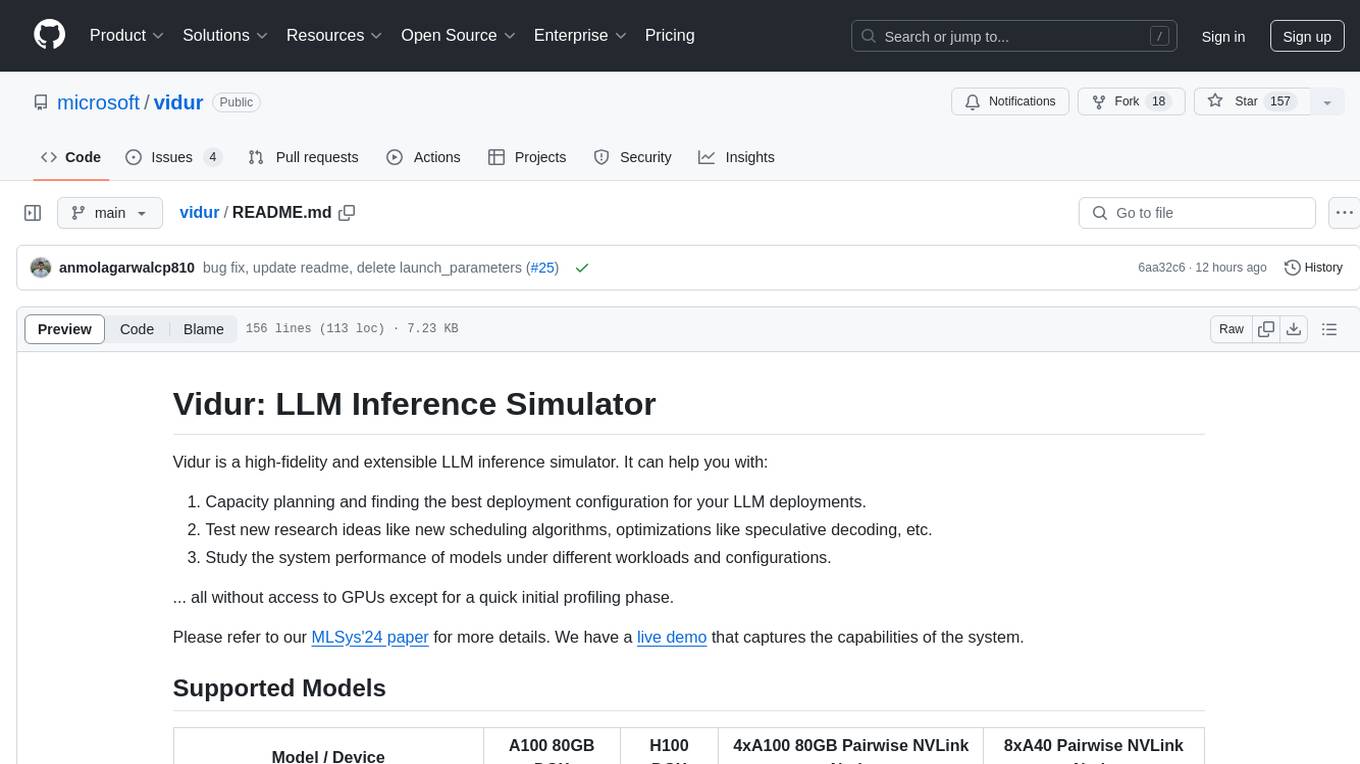
vidur
Vidur is a high-fidelity and extensible LLM inference simulator designed for capacity planning, deployment configuration optimization, testing new research ideas, and studying system performance of models under different workloads and configurations. It supports various models and devices, offers chrome trace exports, and can be set up using mamba, venv, or conda. Users can run the simulator with various parameters and monitor metrics using wandb. Contributions are welcome, subject to a Contributor License Agreement and adherence to the Microsoft Open Source Code of Conduct.
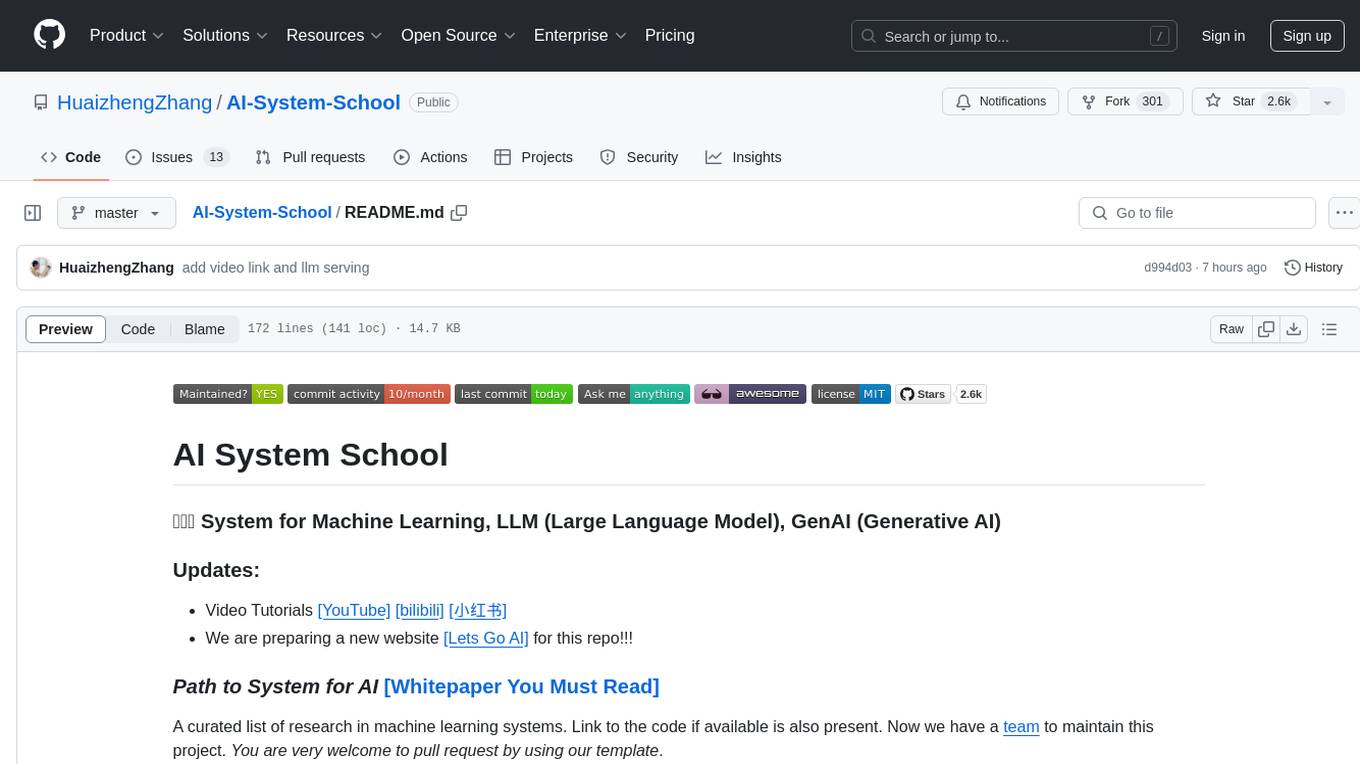
AI-System-School
AI System School is a curated list of research in machine learning systems, focusing on ML/DL infra, LLM infra, domain-specific infra, ML/LLM conferences, and general resources. It provides resources such as data processing, training systems, video systems, autoML systems, and more. The repository aims to help users navigate the landscape of AI systems and machine learning infrastructure, offering insights into conferences, surveys, books, videos, courses, and blogs related to the field.
